How to Make a Book Presentation: A Comprehensive Guide
Are you preparing to give a book presentation whether you’re a student or an aspiring author, delivering an engaging book presentation is a crucial skill. to help you ace your next presentation, we’ve put together a comprehensive guide filled with tips and tricks. let’s get started.


What is a book presentation?
A book presentation is an opportunity to introduce and discuss a specific book to an audience. It involves summarizing the plot, discussing the main themes, and sharing your personal insights. Whether you’re presenting for academic purposes or promoting your own book, a well-organized and captivating book presentation can leave a lasting impression.
Step 1: Choose the right book
The first step in making a book presentation is selecting the right book. Consider your audience, the purpose of the presentation, and your own interests. Choose a book that aligns with these factors to ensure you’ll be motivated and passionate throughout the process.
Step 2: Read and analyze the book
Before you can effectively present a book, you need to thoroughly read and analyze it. Take notes on important plot points, characters, themes, and any significant literary devices used. This will help you provide a comprehensive overview in your presentation.
Step 3: Create an outline
An outline acts as the backbone of your book presentation. It helps you organize your thoughts and ensures a logical flow of information. Divide your presentation into sections such as introduction, plot summary, themes, characters, and your personal analysis. This will make it easier for your audience to follow along.
Step 4: Prepare visuals
Visual aids can greatly enhance your book presentation. Consider creating slides or posters that include images, quotations, and key points from the book. These visuals will not only engage your audience but also help you remember important details during the presentation.
Step 5: Practice, practice, practice
Delivering a polished book presentation requires practice. Familiarize yourself with the content, timing, and transitions. Practice in front of a mirror or record yourself to evaluate your body language, voice modulation, and overall presentation style.
Step 6: Engage your audience
An effective book presentation involves active audience engagement. Encourage questions and discussions throughout your presentation. You can also include interactive activities like quizzes or group discussions to make it more dynamic and interactive.
Step 7: Be confident and enthusiastic
Confidence and enthusiasm are key to delivering a successful book presentation. Stand tall, make eye contact, and use a clear and confident voice. Let your passion for the book shine through, and your audience will be captivated by your presentation.
Step 8: Conclude with a call to action
Wrap up your book presentation with a strong conclusion and a call to action. This can be recommending the book, encouraging further exploration of the author’s works, or even inviting your audience to contribute to a related cause. End on a memorable note that leaves your audience excited to explore the book further.
By following these steps, you’ll be well-prepared to deliver an engaging and memorable book presentation. Remember to personalize your approach and connect with your audience on a meaningful level. Good luck with your presentation and happy reading!
How helpful was this article?
We use essential cookies to make Venngage work. By clicking “Accept All Cookies”, you agree to the storing of cookies on your device to enhance site navigation, analyze site usage, and assist in our marketing efforts.
Manage Cookies
Cookies and similar technologies collect certain information about how you’re using our website. Some of them are essential, and without them you wouldn’t be able to use Venngage. But others are optional, and you get to choose whether we use them or not.
Strictly Necessary Cookies
These cookies are always on, as they’re essential for making Venngage work, and making it safe. Without these cookies, services you’ve asked for can’t be provided.
Show cookie providers
- Google Login
Functionality Cookies
These cookies help us provide enhanced functionality and personalisation, and remember your settings. They may be set by us or by third party providers.
Performance Cookies
These cookies help us analyze how many people are using Venngage, where they come from and how they're using it. If you opt out of these cookies, we can’t get feedback to make Venngage better for you and all our users.
- Google Analytics
Targeting Cookies
These cookies are set by our advertising partners to track your activity and show you relevant Venngage ads on other sites as you browse the internet.
- Google Tag Manager
- Infographics
- Daily Infographics
- Popular Templates
- Accessibility
- Graphic Design
- Graphs and Charts
- Data Visualization
- Human Resources
- Beginner Guides
Blog Beginner Guides How To Make a Good Presentation [A Complete Guide]
How To Make a Good Presentation [A Complete Guide]
Written by: Krystle Wong Jul 20, 2023

A top-notch presentation possesses the power to drive action. From winning stakeholders over and conveying a powerful message to securing funding — your secret weapon lies within the realm of creating an effective presentation .
Being an excellent presenter isn’t confined to the boardroom. Whether you’re delivering a presentation at work, pursuing an academic career, involved in a non-profit organization or even a student, nailing the presentation game is a game-changer.
In this article, I’ll cover the top qualities of compelling presentations and walk you through a step-by-step guide on how to give a good presentation. Here’s a little tip to kick things off: for a headstart, check out Venngage’s collection of free presentation templates . They are fully customizable, and the best part is you don’t need professional design skills to make them shine!
These valuable presentation tips cater to individuals from diverse professional backgrounds, encompassing business professionals, sales and marketing teams, educators, trainers, students, researchers, non-profit organizations, public speakers and presenters.
No matter your field or role, these tips for presenting will equip you with the skills to deliver effective presentations that leave a lasting impression on any audience.
Click to jump ahead:
What are the 10 qualities of a good presentation?
Step-by-step guide on how to prepare an effective presentation, 9 effective techniques to deliver a memorable presentation, faqs on making a good presentation, how to create a presentation with venngage in 5 steps.
When it comes to giving an engaging presentation that leaves a lasting impression, it’s not just about the content — it’s also about how you deliver it. Wondering what makes a good presentation? Well, the best presentations I’ve seen consistently exhibit these 10 qualities:
1. Clear structure
No one likes to get lost in a maze of information. Organize your thoughts into a logical flow, complete with an introduction, main points and a solid conclusion. A structured presentation helps your audience follow along effortlessly, leaving them with a sense of satisfaction at the end.
Regardless of your presentation style , a quality presentation starts with a clear roadmap. Browse through Venngage’s template library and select a presentation template that aligns with your content and presentation goals. Here’s a good presentation example template with a logical layout that includes sections for the introduction, main points, supporting information and a conclusion:

2. Engaging opening
Hook your audience right from the start with an attention-grabbing statement, a fascinating question or maybe even a captivating anecdote. Set the stage for a killer presentation!
The opening moments of your presentation hold immense power – check out these 15 ways to start a presentation to set the stage and captivate your audience.
3. Relevant content
Make sure your content aligns with their interests and needs. Your audience is there for a reason, and that’s to get valuable insights. Avoid fluff and get straight to the point, your audience will be genuinely excited.
4. Effective visual aids
Picture this: a slide with walls of text and tiny charts, yawn! Visual aids should be just that—aiding your presentation. Opt for clear and visually appealing slides, engaging images and informative charts that add value and help reinforce your message.
With Venngage, visualizing data takes no effort at all. You can import data from CSV or Google Sheets seamlessly and create stunning charts, graphs and icon stories effortlessly to showcase your data in a captivating and impactful way.

5. Clear and concise communication
Keep your language simple, and avoid jargon or complicated terms. Communicate your ideas clearly, so your audience can easily grasp and retain the information being conveyed. This can prevent confusion and enhance the overall effectiveness of the message.
6. Engaging delivery
Spice up your presentation with a sprinkle of enthusiasm! Maintain eye contact, use expressive gestures and vary your tone of voice to keep your audience glued to the edge of their seats. A touch of charisma goes a long way!
7. Interaction and audience engagement
Turn your presentation into an interactive experience — encourage questions, foster discussions and maybe even throw in a fun activity. Engaged audiences are more likely to remember and embrace your message.
Transform your slides into an interactive presentation with Venngage’s dynamic features like pop-ups, clickable icons and animated elements. Engage your audience with interactive content that lets them explore and interact with your presentation for a truly immersive experience.

8. Effective storytelling
Who doesn’t love a good story? Weaving relevant anecdotes, case studies or even a personal story into your presentation can captivate your audience and create a lasting impact. Stories build connections and make your message memorable.
A great presentation background is also essential as it sets the tone, creates visual interest and reinforces your message. Enhance the overall aesthetics of your presentation with these 15 presentation background examples and captivate your audience’s attention.
9. Well-timed pacing
Pace your presentation thoughtfully with well-designed presentation slides, neither rushing through nor dragging it out. Respect your audience’s time and ensure you cover all the essential points without losing their interest.
10. Strong conclusion
Last impressions linger! Summarize your main points and leave your audience with a clear takeaway. End your presentation with a bang , a call to action or an inspiring thought that resonates long after the conclusion.
In-person presentations aside, acing a virtual presentation is of paramount importance in today’s digital world. Check out this guide to learn how you can adapt your in-person presentations into virtual presentations .

Preparing an effective presentation starts with laying a strong foundation that goes beyond just creating slides and notes. One of the quickest and best ways to make a presentation would be with the help of a good presentation software .
Otherwise, let me walk you to how to prepare for a presentation step by step and unlock the secrets of crafting a professional presentation that sets you apart.
1. Understand the audience and their needs
Before you dive into preparing your masterpiece, take a moment to get to know your target audience. Tailor your presentation to meet their needs and expectations , and you’ll have them hooked from the start!
2. Conduct thorough research on the topic
Time to hit the books (or the internet)! Don’t skimp on the research with your presentation materials — dive deep into the subject matter and gather valuable insights . The more you know, the more confident you’ll feel in delivering your presentation.
3. Organize the content with a clear structure
No one wants to stumble through a chaotic mess of information. Outline your presentation with a clear and logical flow. Start with a captivating introduction, follow up with main points that build on each other and wrap it up with a powerful conclusion that leaves a lasting impression.
Delivering an effective business presentation hinges on captivating your audience, and Venngage’s professionally designed business presentation templates are tailor-made for this purpose. With thoughtfully structured layouts, these templates enhance your message’s clarity and coherence, ensuring a memorable and engaging experience for your audience members.
Don’t want to build your presentation layout from scratch? pick from these 5 foolproof presentation layout ideas that won’t go wrong.

4. Develop visually appealing and supportive visual aids
Spice up your presentation with eye-catching visuals! Create slides that complement your message, not overshadow it. Remember, a picture is worth a thousand words, but that doesn’t mean you need to overload your slides with text.
Well-chosen designs create a cohesive and professional look, capturing your audience’s attention and enhancing the overall effectiveness of your message. Here’s a list of carefully curated PowerPoint presentation templates and great background graphics that will significantly influence the visual appeal and engagement of your presentation.
5. Practice, practice and practice
Practice makes perfect — rehearse your presentation and arrive early to your presentation to help overcome stage fright. Familiarity with your material will boost your presentation skills and help you handle curveballs with ease.
6. Seek feedback and make necessary adjustments
Don’t be afraid to ask for help and seek feedback from friends and colleagues. Constructive criticism can help you identify blind spots and fine-tune your presentation to perfection.
With Venngage’s real-time collaboration feature , receiving feedback and editing your presentation is a seamless process. Group members can access and work on the presentation simultaneously and edit content side by side in real-time. Changes will be reflected immediately to the entire team, promoting seamless teamwork.

7. Prepare for potential technical or logistical issues
Prepare for the unexpected by checking your equipment, internet connection and any other potential hiccups. If you’re worried that you’ll miss out on any important points, you could always have note cards prepared. Remember to remain focused and rehearse potential answers to anticipated questions.
8. Fine-tune and polish your presentation
As the big day approaches, give your presentation one last shine. Review your talking points, practice how to present a presentation and make any final tweaks. Deep breaths — you’re on the brink of delivering a successful presentation!
In competitive environments, persuasive presentations set individuals and organizations apart. To brush up on your presentation skills, read these guides on how to make a persuasive presentation and tips to presenting effectively .

Whether you’re an experienced presenter or a novice, the right techniques will let your presentation skills soar to new heights!
From public speaking hacks to interactive elements and storytelling prowess, these 9 effective presentation techniques will empower you to leave a lasting impression on your audience and make your presentations unforgettable.
1. Confidence and positive body language
Positive body language instantly captivates your audience, making them believe in your message as much as you do. Strengthen your stage presence and own that stage like it’s your second home! Stand tall, shoulders back and exude confidence.
2. Eye contact with the audience
Break down that invisible barrier and connect with your audience through their eyes. Maintaining eye contact when giving a presentation builds trust and shows that you’re present and engaged with them.
3. Effective use of hand gestures and movement
A little movement goes a long way! Emphasize key points with purposeful gestures and don’t be afraid to walk around the stage. Your energy will be contagious!
4. Utilize storytelling techniques
Weave the magic of storytelling into your presentation. Share relatable anecdotes, inspiring success stories or even personal experiences that tug at the heartstrings of your audience. Adjust your pitch, pace and volume to match the emotions and intensity of the story. Varying your speaking voice adds depth and enhances your stage presence.

5. Incorporate multimedia elements
Spice up your presentation with a dash of visual pizzazz! Use slides, images and video clips to add depth and clarity to your message. Just remember, less is more—don’t overwhelm them with information overload.
Turn your presentations into an interactive party! Involve your audience with questions, polls or group activities. When they actively participate, they become invested in your presentation’s success. Bring your design to life with animated elements. Venngage allows you to apply animations to icons, images and text to create dynamic and engaging visual content.
6. Utilize humor strategically
Laughter is the best medicine—and a fantastic presentation enhancer! A well-placed joke or lighthearted moment can break the ice and create a warm atmosphere , making your audience more receptive to your message.
7. Practice active listening and respond to feedback
Be attentive to your audience’s reactions and feedback. If they have questions or concerns, address them with genuine interest and respect. Your responsiveness builds rapport and shows that you genuinely care about their experience.

8. Apply the 10-20-30 rule
Apply the 10-20-30 presentation rule and keep it short, sweet and impactful! Stick to ten slides, deliver your presentation within 20 minutes and use a 30-point font to ensure clarity and focus. Less is more, and your audience will thank you for it!
9. Implement the 5-5-5 rule
Simplicity is key. Limit each slide to five bullet points, with only five words per bullet point and allow each slide to remain visible for about five seconds. This rule keeps your presentation concise and prevents information overload.
Simple presentations are more engaging because they are easier to follow. Summarize your presentations and keep them simple with Venngage’s gallery of simple presentation templates and ensure that your message is delivered effectively across your audience.

1. How to start a presentation?
To kick off your presentation effectively, begin with an attention-grabbing statement or a powerful quote. Introduce yourself, establish credibility and clearly state the purpose and relevance of your presentation.
2. How to end a presentation?
For a strong conclusion, summarize your talking points and key takeaways. End with a compelling call to action or a thought-provoking question and remember to thank your audience and invite any final questions or interactions.
3. How to make a presentation interactive?
To make your presentation interactive, encourage questions and discussion throughout your talk. Utilize multimedia elements like videos or images and consider including polls, quizzes or group activities to actively involve your audience.
In need of inspiration for your next presentation? I’ve got your back! Pick from these 120+ presentation ideas, topics and examples to get started.
Creating a stunning presentation with Venngage is a breeze with our user-friendly drag-and-drop editor and professionally designed templates for all your communication needs.
Here’s how to make a presentation in just 5 simple steps with the help of Venngage:
Step 1: Sign up for Venngage for free using your email, Gmail or Facebook account or simply log in to access your account.
Step 2: Pick a design from our selection of free presentation templates (they’re all created by our expert in-house designers).
Step 3: Make the template your own by customizing it to fit your content and branding. With Venngage’s intuitive drag-and-drop editor, you can easily modify text, change colors and adjust the layout to create a unique and eye-catching design.
Step 4: Elevate your presentation by incorporating captivating visuals. You can upload your images or choose from Venngage’s vast library of high-quality photos, icons and illustrations.
Step 5: Upgrade to a premium or business account to export your presentation in PDF and print it for in-person presentations or share it digitally for free!
By following these five simple steps, you’ll have a professionally designed and visually engaging presentation ready in no time. With Venngage’s user-friendly platform, your presentation is sure to make a lasting impression. So, let your creativity flow and get ready to shine in your next presentation!
Discover popular designs

Infographic maker

Brochure maker

White paper online

Newsletter creator

Flyer maker

Timeline maker

Letterhead maker

Mind map maker

Ebook maker
Top 10 Best Presentation Books: Transform Your Public Speaking Skills
September 21, 2023
Presentation and Pitch Expert. Ex Advertising.
$100mill In Funding. Bald Since 2010.
In an increasingly competitive world, standing out from the crowd can be a daunting challenge.
One critical skill that sets exceptional individuals apart is the ability to deliver powerful and persuasive presentations. However, mastering this art is no easy feat, and many struggle to captivate their audience, effectively convey their message, and leave a lasting impression.
To overcome these hurdles, it’s essential to learn from the masters of the craft. By studying the techniques and strategies of expert presenters, you can unlock the secrets to creating truly engaging and impactful presentations.
They’ve honed their craft through years of experience, discovering secrets that make presentations truly unforgettable. That’s why we’ve curated a list of the top 10 best presentation books these maestros wrote.
Imagine confidently stepping onto the stage, captivating your audience from the very first moment, and leaving them with an unforgettable message. This can become a reality with the right guidance and resources.
Hey there, I’m Viktor, a pitch deck expert , creative strategist and burger lover. I’ve been a pitch deck expert for the past 10 years and helped clients raise millions and win pitches, with my unique approach to creating pitch decks.
My aim is to guide you through a transformative journey, revealing the books that explain the techniques and strategies employed by the world’s most successful presenters.
So, dive in and let these masters of communication elevate your presentations to new heights of clarity, engagement, and persuasiveness.
Here are the 10 must-read presentation skills books for anyone standing in front of an audience (even if it’s just your wife and you’re trying to convince her).
Hey , before you read on:
Consider doing what others like you did. Reading how to make presentations will take a-lot of time. You need one today (probably) . Let me help you develop a killer presentation and save 10+ hours of your time for a fraction of the cost. All it takes to start is a free 30 min call with me.
The least you will get is 10 actionable tips & strategies to own that next presentation, worth $599, for free.

“Slide:ology: The Art and Science of Creating Great Presentations” by Nancy Duarte
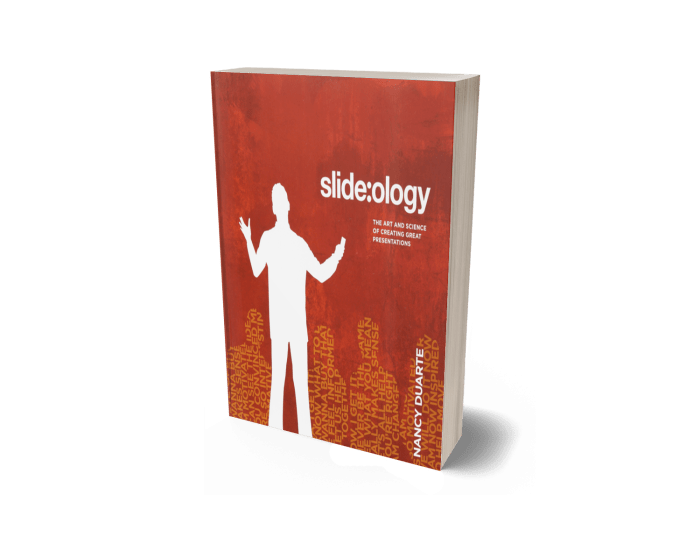
900+ Pros like yourself read the book
Nancy Duarte’s book is a comprehensive guide that aims to revolutionize the way people create and deliver presentations.
The book highlights the importance of visual communication and teaches readers how to design slides that effectively convey their message. Duarte provides a step-by-step approach to crafting visually engaging and impactful presentations, with a strong focus on audience needs and preferences.
Drawing from her extensive experience working with some of the world’s top brands, Duarte shares practical tips and techniques for creating visually stunning slides that leave a lasting impression on the audience.
The book covers various aspects of presentation design, including color theory, typography, layout, and storytelling. “Slide:ology” also emphasizes the significance of simplicity and clarity in slide design, guiding readers to eliminate clutter and focus on the essential elements of their message.
By applying the principles and strategies outlined in this book, you can transform your presentations into powerful tools for communication and persuasion.
Key concepts and techniques
Nancy Duarte covers several key concepts and techniques that can help readers create effective and visually engaging presentations. Some of these key concepts and techniques include:
- Audience-centric approach: Understanding the needs, preferences, and expectations of the audience is crucial in crafting a presentation that resonates with them.
- Storytelling: Integrating storytelling into presentations makes them more memorable and compelling.
- Simplicity and clarity: Effective slide design requires simplicity and clarity.
- Visual communication: Slide:ology emphasizes the importance of using visuals to support the message, as images and graphics are often more effective than text alone.
- Color theory: The book covers the basics of color theory, explaining how different colors can evoke specific emotions and reactions in the audience.
- Typography and layout: Typography and layout play a significant role in making slides readable and visually appealing.
- Data visualization: Presenting complex data in a clear and concise manner is a critical skill in effective presentations.
- Slide preparation and organization: The book offers strategies for organizing slides and building a coherent flow throughout the presentation.
“Resonate: Present Visual Stories That Transform Audiences” by Nancy Duarte
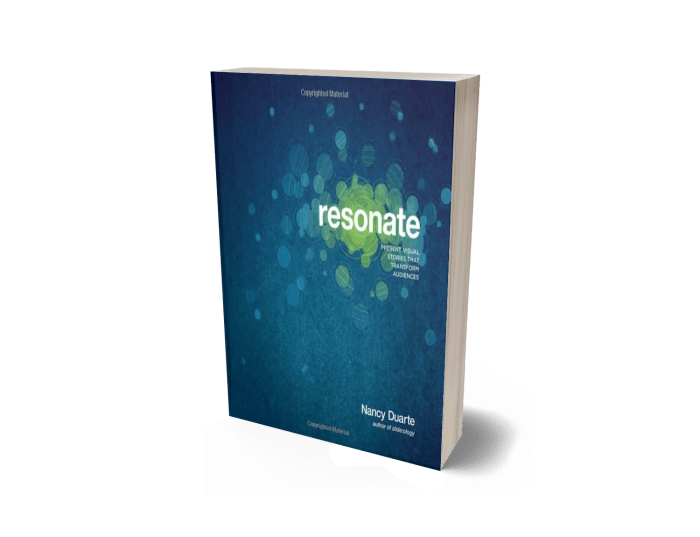
Another one by Nancy Duarte and for a good reason (I always thought I could’ve been her prodigal son) The book she wrote offers a comprehensive guide to creating impactful presentations. Duarte emphasizes the importance of telling a compelling story to engage and persuade an audience, and presents a framework for doing so.
It builds on the concepts introduced in Slide:ology. While Slide:ology focuses on creating effective visual presentations, Resonate takes a more comprehensive approach by emphasizing the importance of storytelling and emotional connection.
The book outlines the five stages of a persuasive presentation, beginning with understanding the audience and their needs, and culminating in a call to action. Along the way, Duarte emphasizes the importance of creating a strong emotional connection with the audience and structuring the presentation to build tension and excitement.
Duarte also offers practical advice on designing effective visual aids, such as slides, diagrams, and charts. She emphasizes the importance of keeping visuals simple and uncluttered, and using them to support and reinforce the key points of the presentation.
Overall, Resonate is a valuable resource for anyone looking to create persuasive and engaging presentations that connect with audiences on a deeper level.
“Presentation Zen: Simple Ideas on Presentation Design and Delivery” by Garr Reynolds

600+ Pros like yourself read the book
Garr’s book is a guide to creating compelling and effective presentations (as are all of the books here!). The book emphasizes the importance of simplicity and clarity in both the design and delivery of presentations.
Reynolds argues that too many presentations rely on cluttered slides, bullet points, and irrelevant details. Instead, he encourages presenters to focus on a simple message and use visuals to support that message. He also stresses the importance of rehearsing and delivering presentations in a natural and engaging manner.
Throughout the book, Reynolds offers practical advice on design principles such as layout, color, and typography, as well as tips for using technology effectively to enhance presentations.
You’ll notice that both Nancy and Garr talk about similar points – that’s because they’re really important in presentation design and delivery.
“The Presentation Secrets of Steve Jobs: How to Be Insanely Great in Front of Any Audience” by Carmine Gallo
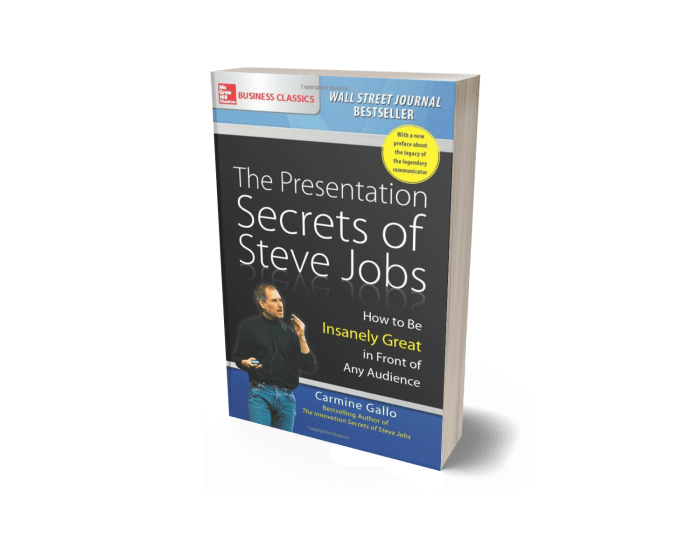
800+ Pros like yourself read the book
This book with an insanely long name by Carmine Gallo is a guide to improving presentation skills through the example of Steve Jobs, the legendary you know who.
Gallo identifies seven key principles that Jobs used to create engaging and memorable presentations. These principles include simplifying the message, creating a clear and compelling storyline, and using visuals to enhance the message.
The book also offers practical advice on how to apply these principles to one’s own presentations, including tips on using technology, preparing for presentations, and delivering speeches with confidence and enthusiasm.
Throughout the book, Gallo uses examples from Jobs’ presentations to illustrate his points, and includes interviews with other successful presenters who have used these principles to achieve success.
Remember the iPod speech? Well, you could potentially make the same impact if you apply the principles of this book.
“Talk Like TED: The 9 Public-Speaking Secrets of the World’s Top Minds” by Carmine Gallo
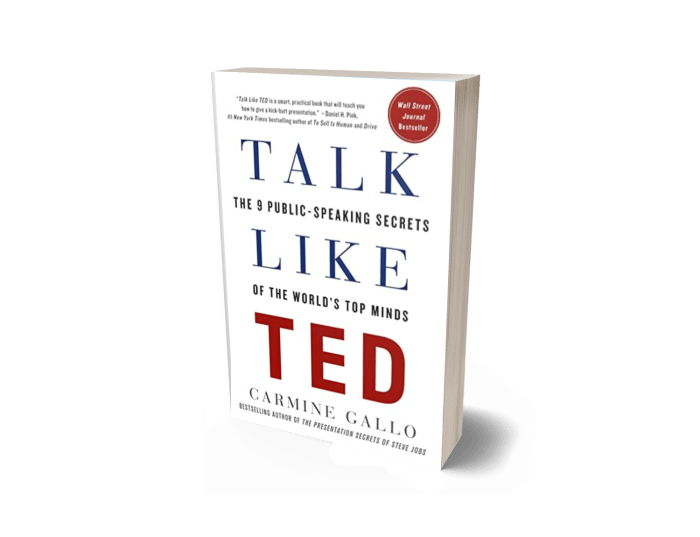
4000+ Pros like yourself read the book
Another great book by Carmine Gallo. This is a guide to improving public speaking skills by analyzing the techniques used by some of the most successful TED speakers.
Gallo identifies nine key principles that successful TED speakers use to create compelling and memorable presentations. These principles include storytelling, using humor, and focusing on a clear and compelling message.
The book provides practical advice on how to apply these principles to one’s own presentations, including tips on using body language, using multimedia effectively, and engaging with the audience.
Throughout the book, Gallo uses examples from successful TED talks to illustrate his points, and includes interviews with successful TED speakers to provide additional insights and inspiration.
Overall, Talk Like TED is a valuable resource for anyone looking to improve their public speaking skills and create more engaging and memorable presentations. By focusing on the techniques used by successful TED speakers, Gallo provides a roadmap for creating truly inspiring speeches.
“Show and Tell: How Everybody Can Make Extraordinary Presentations” by Dan Roam
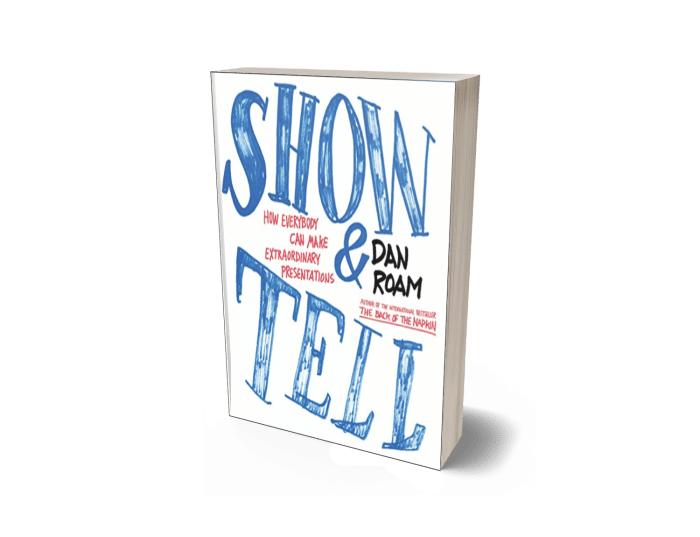
300+ Pros like yourself read the book
Show and Tell is a guide to improving presentation skills by using a visual approach to communication.
Roam argues that the most successful presentations are those that use visual aids to tell a compelling story. He introduces a framework for creating effective presentations that focuses on three key elements: the message, the audience, and the medium.
The book provides practical advice on how to use visual aids, such as sketches and diagrams, to support the message and engage the audience. Roam also emphasizes the importance of understanding the audience and tailoring the presentation to their needs and interests.
Throughout the book, Roam uses examples from successful presentations to illustrate his points, and includes exercises and templates to help readers apply his ideas to their own presentations.
By focusing on the visual aspect of communication, Roam provides a fresh perspective on how to create truly effective presentations.
“The Art of Explanation: Making Your Ideas, Products, and Services Easier to Understand” by Lee LeFever
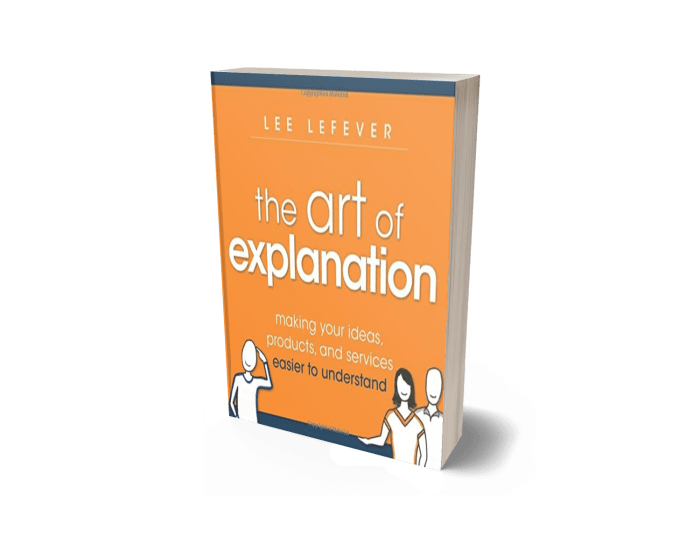
300 Pros like yourself read the book
Lee wants to show us through this guide how to improve communication skills by mastering the art of explanation. Abit different than the other books and for a good reason.
LeFever argues that the most successful communicators are those who can explain complex ideas in simple and understandable terms. He introduces a framework for creating effective explanations that focuses on three key elements: clarity, brevity, and context.
The book provides practical advice on how to use analogies, metaphors, and storytelling to help audiences understand even the most complex ideas. LeFever also emphasizes the importance of understanding the audience and tailoring the explanation to their needs and interests.
Throughout the book, LeFever uses examples from successful explanations to illustrate his points, and includes exercises and templates to help readers apply his ideas to their own communication challenges.
By focusing on the art of explanation, Lee provides a practical and actionable guide for making even the most complex ideas understandable to others.
“Made to Stick: Why Some Ideas Survive and Others Die” by Chip Heath & Dan Heath
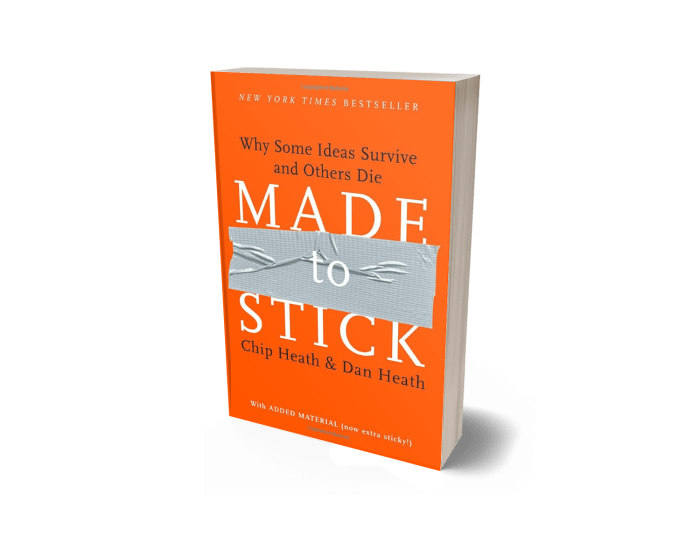
5000+ Pros like yourself read the book
Chip and Dan Heath (or Chip and Dale) explore the elements that make ideas memorable and influential. The authors present six key principles, encapsulated in the acronym SUCCESs:
- Simplicity : Effective ideas are simple, core messages that are easy to understand and remember.
- Unexpectedness : Ideas that surprise or challenge expectations are more likely to grab attention and stick in people’s minds.
- Concreteness : Concrete ideas, with specific examples and tangible details, are more relatable and easier to visualize.
- Credibility : Ideas backed by credible sources, statistics, or testimonials are more persuasive and memorable.
- Emotions : Ideas that evoke emotions, either positive or negative, create a stronger connection with the audience.
- Stories : Telling stories helps to convey ideas in a compelling and engaging way, making them more likely to be remembered and shared.
By applying these principles, individuals and organizations can develop more effective communication strategies and make their ideas stickier.
“Confessions of a Public Speaker” by Scott Berkun
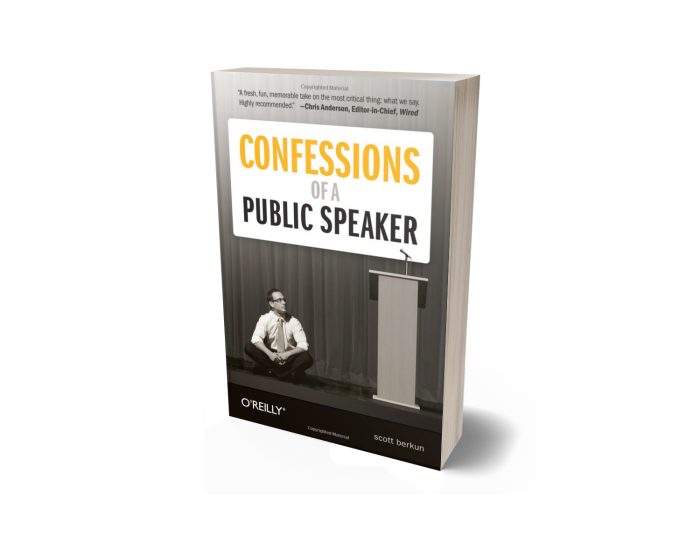
500+ Pros like yourself read the book
Scott Berkun offers an honest and entertaining look into the world of professional public speaking. Berkun shares his personal experiences and insights to help readers improve their presentation and communication skills. The book covers a wide range of topics, from overcoming stage fright to engaging audiences effectively.
Berkun emphasizes that practice, preparation, and self-awareness are crucial to becoming a successful public speaker. He advises readers to know their material thoroughly, understand the audience, and create a strong opening to capture attention. To keep audiences engaged, he suggests using humor, storytelling, and varying one’s speaking pace and tone.
The book also covers handling difficult situations, such as dealing with technical issues, unresponsive audiences, or hostile questions. Berkun stresses the importance of staying calm, thinking on one’s feet, and learning from every experience. Ultimately, “Confessions of a Public Speaker” provides valuable tips and candid stories to help anyone become a more confident and effective communicator.
“Steal the Show: From Speeches to Job Interviews to Deal-Closing Pitches” by Michael Port
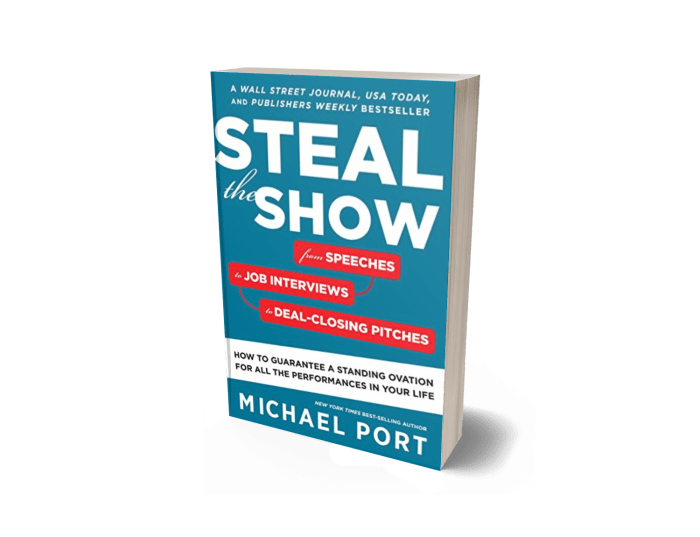
Michael Port offers a comprehensive guide to mastering the art of public speaking and persuasive communication in various settings. Port emphasizes the importance of performance in all aspects of life, from delivering speeches to acing job interviews and winning business deals.
The book provides actionable strategies for improving one’s performance skills, such as understanding the audience, crafting compelling stories, and developing a strong stage presence. Port stresses the need to be authentic and genuine, while also being aware of nonverbal communication and vocal dynamics.
“Steal the Show” also covers essential preparation techniques, including extensive research, rehearsal, and mental visualization. Port advises readers to manage their nerves through mindfulness and self-awareness. He also shares tips on handling challenging situations and improvising when things don’t go as planned.
Best Presentation Books Wrap Up
In conclusion, the top 10 best presentation books provide a wealth of knowledge and practical advice for mastering public speaking and persuasive communication.
These books, including “Made to Stick,” “Confessions of a Public Speaker,” and “Steal the Show,” among others, offer valuable insights into various aspects of delivering engaging and effective presentations.
Exploring these resources is highly recommended for anyone looking to improve their public speaking skills, whether they are seasoned professionals or just starting their journey. By learning from the experiences and expertise of these accomplished authors, readers can develop their unique style and confidence in presenting their ideas.
Effective presentations play a crucial role in both personal and professional life, as they help convey ideas, persuade others, and create lasting impressions. By investing time and effort in honing one’s presentation skills, individuals can unlock new opportunities, foster meaningful connections, and make a significant impact on others.
If you got here, then you should reconsider my offer.
Additional Resources
If you’re still looking to improve your presentation skills, check this list on the best books for pitching.
Or explore more resources on presentations and pitches:
Also don’t miss out on my massive presentation specialist guide , last minute presentations and best business projector buyers guide.
THE Pitching Guide – How To Create a Winning Pitch
https://viktori.co/pitching-example/
44 Public Speaking Tips
Persuasion IQ summary
1 thought on “Top 10 Best Presentation Books: Transform Your Public Speaking Skills”
Excellent will explore further
Leave a Comment Cancel reply
Save my name, email, and website in this browser for the next time I comment.
Viktori . Pitching your way to your next funding. Or client.
Clutch Certified
Top Rated On Upwork

Viktori.co is a participant in the Amazon Services LLC Associates Program, an affiliate advertising program designed to provide a means for sites to earn advertising fees by advertising and linking to Amazon.com.
Pitch Deck Resources
- Pitch Deck Guides
- Pitch Deck Outlines
- Pitch Examples
Presentation Resources
- Presentation Guides
- Get A Pitch Deck
Office: 633 North Wells Street Chicago, IL, United States 60654 HQ : Boulevard P.O. 10000 Skopje, North Macedonia
Table of Contents
How to make a great presentation
Stressed about an upcoming presentation? These talks are full of helpful tips on how to get up in front of an audience and make a lasting impression.

The secret structure of great talks

The beauty of data visualization

TED's secret to great public speaking

How to speak so that people want to listen

How great leaders inspire action
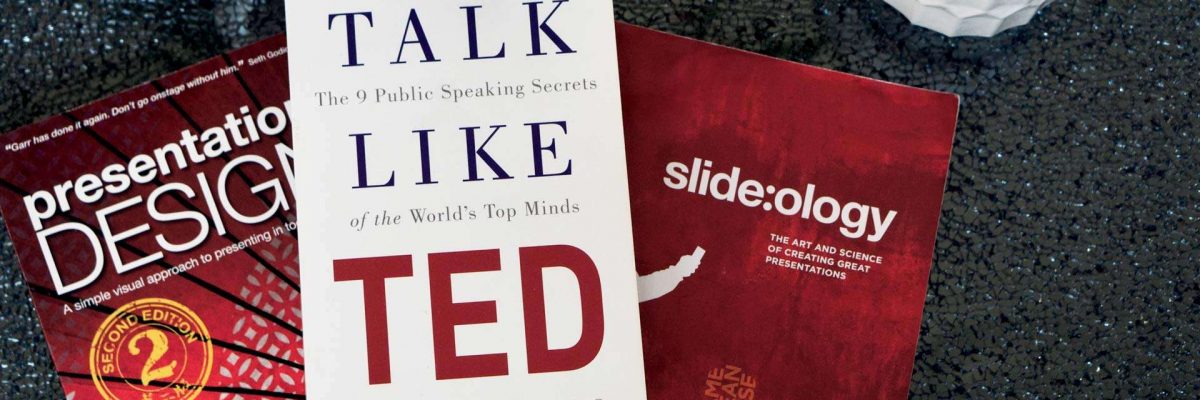
- By Illiya Vjestica
- - September 30, 2020
What are the Must-Read Essential Presentation Books?
We have put together, six of the best must-read presentation books on everything presenting and PowerPoint design. We began our own journey from these presentation books, and they can teach you too.
We’ve got to hand it to the internet.
It teaches us a lot of things. On YouTube alone, there are tutorials for everything from doing eerily realistic special effects makeup to building a house. Elsewhere – at just a click of your mouse – you can find forums and websites full of insights across every skill imaginable.
But there’s some knowledge you can only get from books.

Books have a wealth of knowledge available to you, the feeling of turning the pages in your hand can’t be beaten.
You can access specific interviews with leading figures in your industry. Learn tips and methodology that have been refined over decades – compiled precisely in the right order, in clear chapters, to help you digest it all.
With that in mind, we’re always on the lookout for the best presentation books on presenting and presentation design.
There are some brilliant titles out there that’ll help you to boost your presentation design and public speaking skills to a staggering degree – giving you an edge over your competitors.
The books we have selected will help you to deliver talks that capture hearts as well as minds.
Here are our six must-read presentation books we’d recommend you add to your home library.
1. Talk Like TED: The 9 Public Speaking Secrets of the World’s Top Minds, Carmine Gallo
In this book, Carmine Gallo puts forward a straightforward step-by-step method for anyone to deliver a presentation that is engaging, persuasive, and most importantly, memorable.
If you’re familiar with us at The Presentation Designer, you’ll already know we’ve created slides for TED talks before. They’re the gold standard when it comes to public speaking… and with this book, you can learn all the tricks of the trade from some of the best TED presenters around.
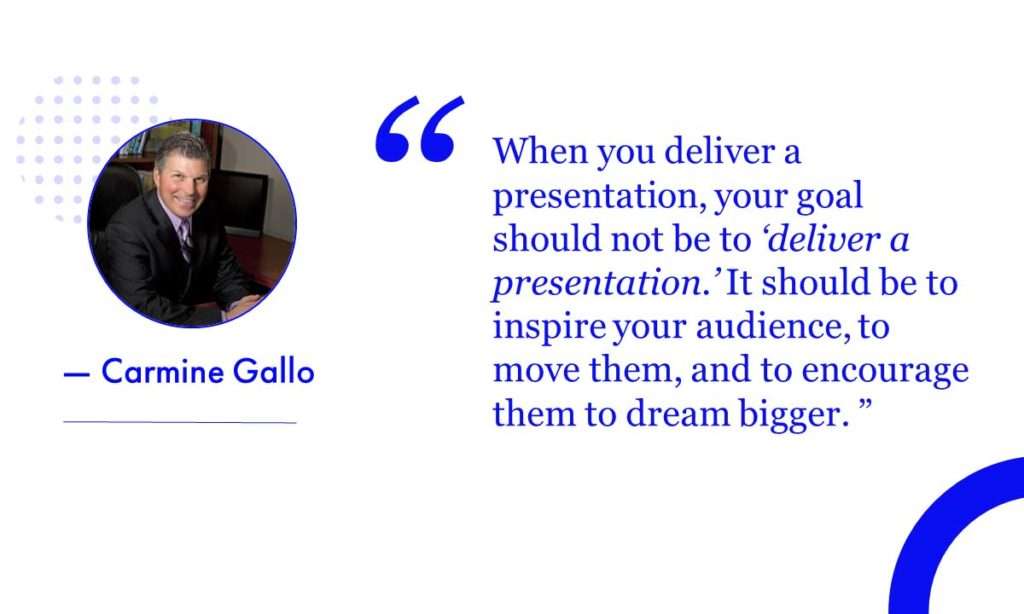
From interviews with popular TED speakers to insights on how to design and deliver your presentation, this handy guide will help you to present like a pro. Are you ready to knock your audience’s socks off?
2. Presentation Zen Design: A simple visual approach to presenting in today’s world, Garr Reynolds
There’s probably nobody better qualified to give presentation advice than Garr Reynolds (other than us, of course!).
A best-selling author and popular speaker, he’s got wisdom on tap when it comes to delivering terrific talks – and nailing every element of your presentation design. I’ve read every single book Garr has published.
Presentation Zen Design is the book I would recommend to anyone thinking about creating more effective presentation slides.
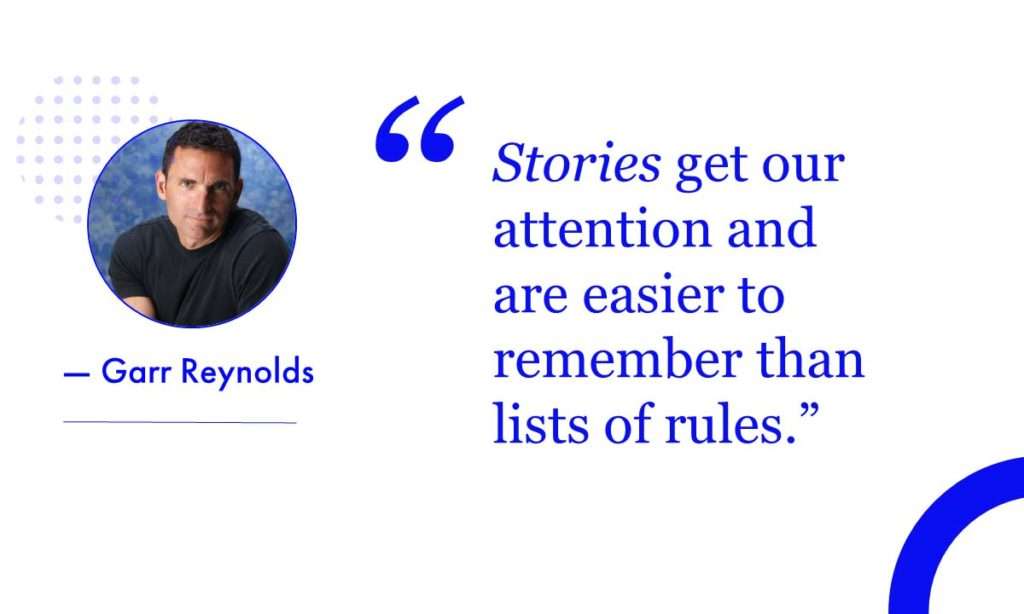
Throughout, you’ll find simple design principles and techniques that are guaranteed to enhance your presentations. In Garr’s book you will also gain an insight into Japanese Zen and how you can apply some of its principles to improve engagement with your audience.
It doesn’t matter how smart and a detailed a slide design can be, Garr’s methods prove that ‘keeping it simple is best’.
Check out his tips on the best ways to use colour, data, mixed mediums (including video) and more to create simple, synergistic and stunning presentations. Check it out.
3. slide:ology: The Art and Science of Creating Great Presentations: The Art and Science of Presentation Design, Nancy Duarte
In slide:ology, communications expert Nancy Duarte delivers innovative advice around “visual thinking” – helping your audience to understand your key messages through imagery.
Connect with specific experts, create easy-to-understand graphics and use the power of art to persuade. Using her intriguing insights and step-by-step instructions, you’ll be able to master the craft of presenting.
There are plenty of case studies to refer too, which demonstrate how some of the world’s leading brands have used Duarte’s visual theories and methods to achieve their goals.
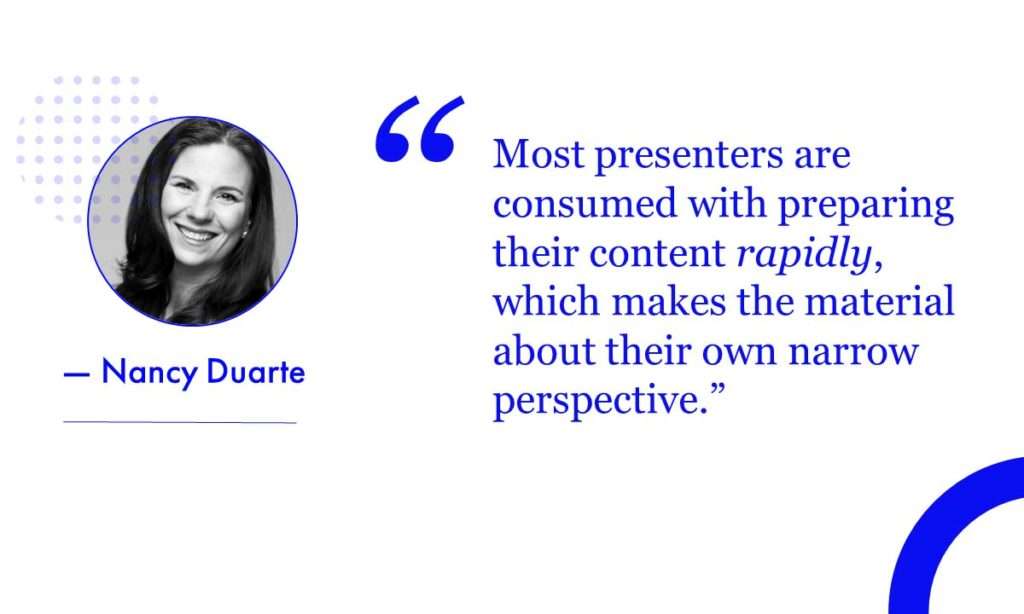
Want to learn how to create slides an audience can process?
Then, this is the book for you, it’s difficult not to also recommend ‘Resonate’, her follow-up, as another must-read book.
Her second book will take your learning further to help you create better stories for your presentation and develop supporting visuals that fit your narrative.
Thank you, Nancy! You have taught me so much!
4. Confessions of a Public Speaker, Scott Berkun
Stage fright. Bored audiences. Forgetting your lines. Even the most confident of us have fears when it comes to giving presentations. Fortunately, author and public speaking specialist Scott Berkun is sympathetic to that – and between his practical advice and hilarious, insightful anecdotes, Scott teaches you how to present perfectly… without the panic element. Sounds good to us.
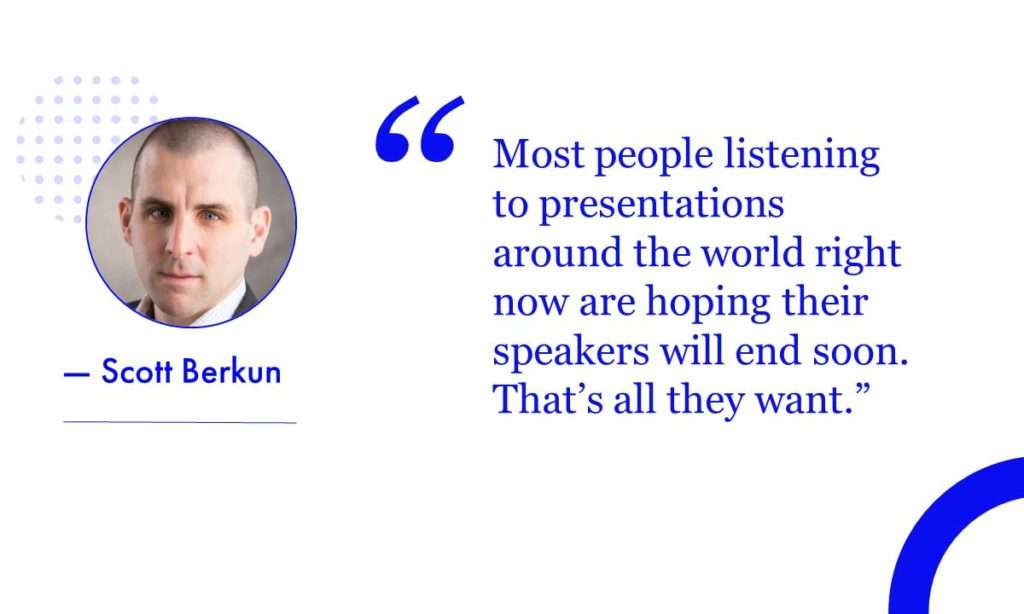
Through his years of experience speaking to crowds of all different sizes, you’ll gain an insight to:
- How to work a tough audience
- The science of not boring people to sleep
- How to survive the attack of nerves or worry
- What to do when things go wrong
5. Show and Tell: How Everybody Can Make Extraordinary Presentations, Dan Roam
There are two decades worth of presentation wisdom in Dan Roam’s Show and Tell . His theory is that we’re all natural-born storytellers.
In his book ‘Show and Tell’ he guides our focus on unlocking our innate presenting abilities in a fun, engaging and informative way. Through fundamental truths (including our personal favourite: “passion = self-confidence”), hand-drawn pictures and simple-to-remember tips, you’ll find a fantastic foundation for both your presentation design and delivery.
There’s a lot of informative content about telling better stories in our presentation and how to structure them to make them engaging.
Cheers, Dan.
6. Interaction of Color, Josef Albers
At The Presentation Designer, we’re serious when it comes to harnessing the power of colour in presentation design. It’s a good thing, too, as colour theory and psychology play massive roles in the potential impact of your slides.
Josef Albers’ famous book, Interaction of Colour , is testament to that fact: a comprehensive guide on the principles of colour theory that’s been in circulation since the 60s.
Age certainly equals wisdom, here, because Albers’ in-depth manual – which discusses everything from colour relativity to the illusion of transparency – is chockablock with all the information you’ll ever need to know about using colour. You’ll be the Picasso of presentations in no time.
I’ve included this video from painter Albert van der Zwart who explains the concepts around Josef Albers principles of colour theory well.
There you go, I hope you’ve enjoyed our recommended presentation books. Let us know any you think we’ve missed in the comments.
Other Recommend Reading:
If you have enjoyed this post we’ve also included some helpful links to our blog posts that you might find useful:
- 5 PowerPoint Tips You Should Know
- How to Improve Presentation Retention Rates
- How to Overcome Your Fear of Public Speaking
- 5 Classic Presentation Fonts
Don’t want to go it alone? We’ve got a brilliant process in place to help you build your presentation… and we’ll give you a free quotation, too. Come say hi!
Illiya Vjestica
Share this post:, leave a comment cancel reply.
Your email address will not be published. Required fields are marked *
How to make a book presentation
When it comes to promoting and selling your publication, book presentations play a major part. Are you interested in finding more about how to create a well-structured presentation ? Luckily, you landed on the right page. This article helps you understand the process behind making a successful presentation in Flipsnack. Just keep in mind the next steps we’re going to debate and enjoy the process. So, to cut a long story short here are 5 useful tips on how to make a book presentation:
- Select a book. Decide on what book you want to make a presentation .
- Collect information. Make a research about the author’s biography, reviews, and other books.
- Start designing the page layouts. Flipsnack offers a fantastic online editor.
- Add interactive elements. Integrate video, captions, hyperlinks, and other interactive elements in your design.
- Download or publish it online. Display your book presentation publicly or private.
I was recently asked to design a book promo in both Indesign and Flipsnack, to show publishers how well Flipsnack works for them. I chose one of my favorite authors, Donald Miller.
About Donald Miller
This book presentation is focused on the work of Donald Miller, who usually writes about his life experience and his struggles, in a friendly way. His stories inspire people to fall in love with life and to live it at the highest level. He is better known for the New York Times Best Sellers: “Blue like Jazz”, “Million Miles in a Thousand Years”, but he’s written many other great books. I encourage you to read them.
His most recent publication is Scary Close, and it is the main focus of my book presentation .
Below you can see what I designed.
Because I like how the project turned out, I thought I should give you some tips on how you can make similar book promos.
Using Flipsnack for a book presentation
Flipsnack is a complex tool for creating brochures, newspapers, magazines, and books. Whether you are a professional designer or a high schooler the process of ‘“ how to make a book presentation” has never been easier. You just have to select a template or create the presentation from scratch, choose the page layouts, to arrange the text and images on the page, add the photos and make it a flipbook . Then publish it and share it on social media or via email with your wide audience. With the help of Flipsnack you’ll be an expert at designing fabulous academic presentations in no time.
What should a book presentation contain?
There is some important information that every book catalog or book promo should contain. It should present some interesting info that will entice the reader to buy the book. The content shouldn’t be too long or too short. Here are some ideas of what could be included in a book promo:
- Book presentation
- Main characters description
- Other books
- Interview with the author
Conclude the presentation with a closing paragraph sharing the most important lessons learned from the book and what you consider the most important message that you drew out from it.
Nowadays visual marketing is very important, so try to turn your book presentation into something beautiful, fascinating, with a design that matches the writer’s style.
How to integrate interactive elements in your design
When you design a publication in Adobe InDesign, Photoshop, Illustrator, etc. reserve some white space for the interactive elements. Make interactivity a part of your design, and you’ll be surprised of what a big improvement it will bring to your project.
These text blurbs are great for highlighting quotes, for additional information, or for short descriptions. I used captions in the biography section to add some information about Donald Miller’s photos.
What is so great about captions is that you can use them to bring more color and contrast to your designs. Captions will also help you save space, by not revealing all text at once. This way, your design will have room to breathe.
Readers will love to click on captions to see what they reveal. The caption has that element of surprise, that we all love.
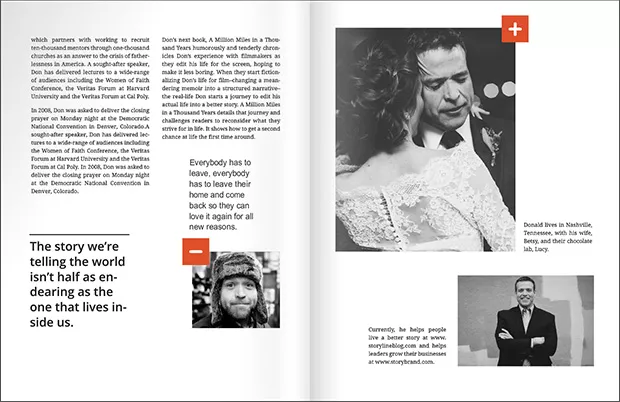
For the book presentation I chose a video tag, through which readers can watch an interview with Miller about his new book “Scary Close”. Tags are a great tool for adding videos or images to a design, because they are small and you can place them anywhere on the page. Just like captions, you can use them to de-clutter a design, prevent visual noise, while keeping all the needed information on the page. To catch the readers’ eyes, tags use a subtle blinking effect.
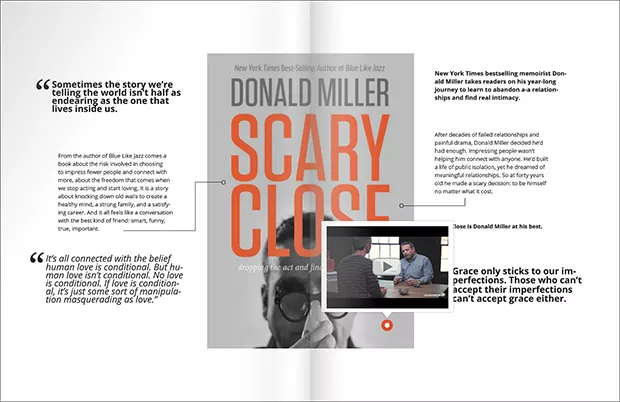
“Buy This” Button
If you’re showcasing other books of the author you should make it easy for readers to buy them. You can do that by just adding some buy buttons . Insert the Amazon URL, (or any other URL for that matter) and with just one click the user will be able to buy it.
Buy buttons are very easy to use and they are very practical. They can help you sell, and that is the ultimate goal of any book catalog or book presentation.

Video Widget
After you read some paragraphs of an interview you probably become curious about how the writer would say those things. You don’t have to search for videos on Youtube, because with the video widget you can have it play right there on your page. You just have to reserve some space in your design for this. You will not regret it.

This is how you can use Flipsnack to create a digital book or interactive experience for readers, which will make them interested in buying the book. Also if you are searching for a platform with a good reputation to sell your work, Flipsnack is the right place for you. Now you can sell and publish your publication in no time. The first step when setting your work for sale is to connect your Flipsnack account with Stripe. The second step is to set a price for the publication. Usually, the price of a digital magazine varies between $3 – $6, depending on the page number of the publication and then c hoose the right preview pages. Make sure the pages included in your preview edition share enough information, so your readers are attracted to purchase it.
After you set your publication for sale, you can find the statistics in the Stats section in your account. With the help of Flipsnack reaching readers from all over the globe has never been easier! Learn more about how to sell your digital magazines here!
All of my books are taken from Jewish sources. My writing is taken from the Sages who shapes the Jewish people in the past through today.
That was cool thing about a books
Leave A Comment Cancel reply
Save my name, email, and website in this browser for the next time I comment.
Related Posts
Marketing & digital publishing terms glossary.
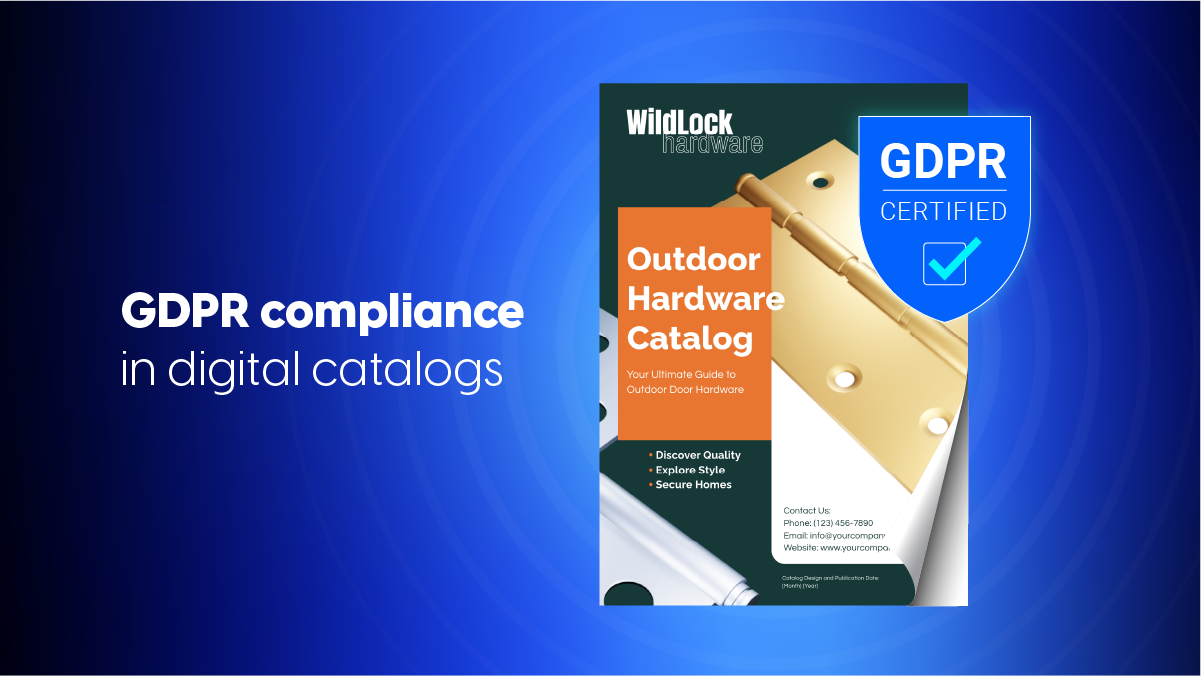
Navigating GDPR compliance in digital catalogs
The online flipbook maker.
Flipsnack © Copyright 2022 – All rights reserved.
Create a digital magazine
Make an online catalog, create a digital brochure, make a digital newsletter, privacy policy, help center.

- Kindle Store
- Kindle eBooks
- Business & Money
Promotions apply when you purchase
These promotions will be applied to this item:
Some promotions may be combined; others are not eligible to be combined with other offers. For details, please see the Terms & Conditions associated with these promotions.
Buy for others
Buying and sending ebooks to others.
- Select quantity
- Buy and send eBooks
- Recipients can read on any device
These ebooks can only be redeemed by recipients in the US. Redemption links and eBooks cannot be resold.

Download the free Kindle app and start reading Kindle books instantly on your smartphone, tablet, or computer - no Kindle device required .
Read instantly on your browser with Kindle for Web.
Using your mobile phone camera - scan the code below and download the Kindle app.

Follow the author

Image Unavailable

- To view this video download Flash Player
Presentation Skills: How To Make A Great Presentation Kindle Edition
'how to make a great presentation' .
'How to make a great presentation' combats the fear of presenting that so many people have.
Making a good presentation isn't as difficult as you may think. This book will show you a simple step by step method which covers understanding your audience, how to create an effective PowerPoint slide, how to use effective presentation skills and more. By creating a good presentation your audience will leave the room remembering more and you will feel that you have achieved. 'How to make a great presentation' shows you the steps you need to make your next presentation great.
- Print length 82 pages
- Language English
- Sticky notes On Kindle Scribe
- Publication date August 30, 2012
- File size 1043 KB
- Page Flip Enabled
- Word Wise Enabled
- Enhanced typesetting Enabled
- See all details
Product details
- ASIN : B0094CC7KG
- Publisher : Liam Lusk (August 30, 2012)
- Publication date : August 30, 2012
- Language : English
- File size : 1043 KB
- Simultaneous device usage : Unlimited
- Text-to-Speech : Enabled
- Screen Reader : Supported
- Enhanced typesetting : Enabled
- X-Ray : Not Enabled
- Word Wise : Enabled
- Sticky notes : On Kindle Scribe
- Print length : 82 pages
- #1,849 in Running Meetings & Presentations (Kindle Store)
- #3,794 in Running Meetings & Presentations (Books)
- #4,765 in Business Communication Skills
About the author
I was born in Paisley, Scotland and moved to England at the age of 8 where I spent my childhood.
My involvement in the business world began over 20 years ago in London where I started my professional career in the theatre industry at the world famous London Palladium theatre.
After moving to Korea in 2001 I became involved in the presentation and English communication coaching sector.
I have been an active person on the internet since 2006 having run both successful blogs and businesses.
I now spend my time lecturing on presentation skills, social media and running my consulting company.
I live with my wife and daughter in Seoul, Korea.
I also co-author English learning books and children's books with Scott Worden who is from Monterey Park, California, USA.
Scott and I first met in Seoul, South Korea 2005. Due to our combined experience in teaching young learners' English, Scott's knowledge of helping children with special needs, and my experience as a father we decided to also write material for young children.
Customer reviews
Customer Reviews, including Product Star Ratings help customers to learn more about the product and decide whether it is the right product for them.
To calculate the overall star rating and percentage breakdown by star, we don’t use a simple average. Instead, our system considers things like how recent a review is and if the reviewer bought the item on Amazon. It also analyzed reviews to verify trustworthiness.
- Sort reviews by Top reviews Most recent Top reviews
Top reviews from the United States
There was a problem filtering reviews right now. please try again later..
Top reviews from other countries
Report an issue
- Amazon Newsletter
- About Amazon
- Accessibility
- Sustainability
- Press Center
- Investor Relations
- Amazon Devices
- Amazon Science
- Sell on Amazon
- Sell apps on Amazon
- Supply to Amazon
- Protect & Build Your Brand
- Become an Affiliate
- Become a Delivery Driver
- Start a Package Delivery Business
- Advertise Your Products
- Self-Publish with Us
- Become an Amazon Hub Partner
- › See More Ways to Make Money
- Amazon Visa
- Amazon Store Card
- Amazon Secured Card
- Amazon Business Card
- Shop with Points
- Credit Card Marketplace
- Reload Your Balance
- Amazon Currency Converter
- Your Account
- Your Orders
- Shipping Rates & Policies
- Amazon Prime
- Returns & Replacements
- Manage Your Content and Devices
- Recalls and Product Safety Alerts
- Conditions of Use
- Privacy Notice
- Consumer Health Data Privacy Disclosure
- Your Ads Privacy Choices
Bringing you weekly presentation productivity pointers to help you finish that deck faster and deliver more impact at work.
Top 9 Presentation Design Books (2023)

Hey there, slide slayer! 🦸♂️ Looking for the perfect resource to level up your presentation design game? Look no further! I've compiled a list of the best (and my favorite) presentation design books that will turn your slides from 'meh' to 'WOW.' Say goodbye to boring presentations and hello to captivating, engaging visuals. Let's dive in!
What Are the Best Presentation Design Books?
I've handpicked these amazing books, packed with insights, tips, and techniques to help you create stunning presentations. Whether you're a new grad or a working professional, these books have got you covered. Let's explore them one by one.
Slide:ology: The Art and Science of Creating Great Presentations

Written by presentation expert Nancy Duarte, Slide:ology is a must-read for anyone looking to improve their slide design skills. This comprehensive guide covers everything from storytelling to slide layout and design principles.
What I Liked
- Step-by-step guidance on designing effective presentations
- Beautiful visuals and examples from well-known companies
- Great case studies highlighting the people
- Clear authority in the field since she designed Al Gore's famous climate change slide deck that was the basis for an Inconvenient Truth film
- Clear explanations of design concepts
- Focus on storytelling and audience engagement
- Good focus on timeless ideas
- The print book is beautifully designed
- More hands-on exercises and activities
Bottom Line
This book is perfect for anyone looking to master the art of creating visually stunning and impactful presentations, regardless of their design background.
Resonate: Present Visual Stories that Transform Audiences

Another gem from Nancy Duarte, Resonate focuses on the power of storytelling to create memorable and persuasive presentations. Learn how to connect with your audience and leave a lasting impact.
- Unique approach to visual storytelling
- Incorporation of narrative structure in presentations
- Emphasis on audience engagement and connection
- Variety of case studies from different fields
- Tips for effective slide design and layout
- Expanded section on slide design tools and resources
If you want to learn the art of storytelling in presentations and captivate your audience, this book is a fantastic choice.
DataStory: Explain Data and Inspire Action Through Story

DataStory, also by Nancy Duarte, is a valuable guide for those looking to effectively communicate complex data through storytelling. Discover how to turn numbers into compelling narratives that drive action.
What I Liked:
- Clear explanations of data visualization concepts
- Practical tips for transforming data into stories
- Examples from various industries
- Focus on audience understanding and decision-making
- Techniques for creating persuasive data-driven presentations
- More detailed guidance on data visualization tools
- Expanded coverage of data analysis techniques
Ideal for professionals working with data, this book will help you present complex information in a clear, engaging, and persuasive manner.
Everyday Business Storytelling: Create, Simplify, and Adapt A Visual Narrative for Any Audience

Authors Janine Kurnoff and Lee Lazarus provide practical guidance on using visual storytelling to create effective business presentations. Learn how to simplify complex ideas and adapt your message for any audience.
- Step-by-step process for crafting visual narratives
- Emphasis on audience-centered communication
- Real-world examples and case studies
- Tips for adapting messages to different audiences and contexts
- Techniques for simplifying complex information
- Plenty of examples with before and afters
- The section about email communication because not everything has to be a presentation
- Even more examples at the end
This book is perfect for business professionals who want to create engaging and persuasive visual narratives that resonate with any audience.
Storytelling with Data: A Data Visualization Guide for Business Professionals

Written by Cole Nussbaumer Knaflic, Storytelling with Data teaches readers how to present data in a clear and compelling way. Gain valuable insights on data visualization techniques and best practices for business professionals.
- In-depth coverage of data visualization best practices
- Focus on audience-centric presentation design
- Strategies for simplifying complex data
- Tips for selecting the most effective chart types
- Guidance on using color and design elements effectively
- Additional exercises and activities for hands-on practice
This book is ideal for business professionals who want to master data visualization and deliver clear, compelling data-driven presentations.
Good Charts: The HBR Guide to Making Smarter, More Persuasive Data Visualizations

Authored by Scott Berinato, Good Charts is a comprehensive guide to creating data visualizations that effectively communicate complex information. Learn best practices and techniques for creating persuasive and informative charts and graphs.
- Practical guidance for creating effective charts and graphs
- Harvard Business Review's credibility and expertise
- Tips for improving existing data visualizations
- Strategies for engaging and persuading audiences with data
- Expanded coverage of advanced visualization techniques
This book is perfect for professionals seeking to improve their data visualization skills and create more persuasive presentations using data.
Good Charts Workbook: Tips, Tools, and Exercises for Making Better Data Visualizations

A companion to Good Charts, the Good Charts Workbook by Scott Berinato offers hands-on exercises and practical tools to help you create better data visualizations. Improve your skills with engaging activities and real-world examples.
- Interactive exercises and activities
- Focus on hands-on learning and skill development
- Complements the concepts covered in Good Charts
- Tips for refining and improving existing visualizations
- Greater variety of data visualization tools covered
- Inclusion of digital resources and templates
Ideal for those looking to practice and improve their data visualization skills, this workbook is a valuable resource for creating more effective and persuasive data-driven presentations.
The Elegant Pitch: Create a Compelling Recommendation, Build Broad Support, and Get It Approved

Written by Mike Figliuolo, The Elegant Pitch provides a structured approach to crafting persuasive business recommendations. Learn how to build support and get your ideas approved with a clear, compelling pitch.
- Step-by-step process for creating persuasive pitches
- Focus on clarity and simplicity in communication
- Tips for overcoming objections and building support
- Techniques for tailoring your pitch to different audiences
- Well written book with very actionable advice
- More of a hidden gem that isn't talked about as much
- Greater emphasis on visual presentation techniques
This book is perfect for professionals who want to learn how to create compelling recommendations and get their ideas approved in a business setting.
Presentation Zen Design: Simple Design Principles and Techniques to Enhance Your Presentations

In Presentation Zen Design, Garr Reynolds shares his expertise on creating visually stunning and engaging presentations. Discover simple design principles and techniques to transform your slides and captivate your audience.
- Focus on clean, minimalist design principles
- Practical tips for improving slide design
- Real-world examples from various industries
- Strategies for incorporating visuals effectively
- Techniques for engaging and connecting with audiences
- Very culturally sensitive
- Eastern cultural themes and analogies
- An updated edition is needed because, visually, some of the examples feel very out of date

This book is ideal for those looking to enhance their presentation design skills and create visually engaging slides that resonate with their audience.
So there you have it, my top picks for the best presentation design books. Whether you're just starting or want to polish your skills, these books will help you create captivating, engaging slides that leave a lasting impression.
Ready to get started? Grab one of these books and watch your presentations transform! 🚀
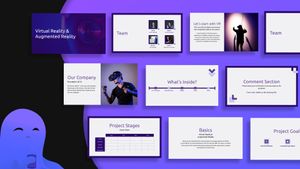
Decktopus AI Review 2023


Best AI Presentation Software 2023

Best PowerPoint Tool for Creating Charts 2023: Think Cell

Nicholas C. Rossis
dream-protecting author
7 Tips to Write a Killer Book Presentation
Jul 11, 2020 | Marketing , My friends' Guest Posts

Sometimes, a book you have written draws enough attention that you are asked to speak about it to an audience. You may be asked to present as a subject expert, talk about your material at a conference or convention, present at a book fair , or give a quick presentation as part of a book signing.
As they say, more people are afraid of public speaking than of death. Which means that most people would prefer being in a casket than giving the obituary.
And now, you’re going to be in front of an audience discussing your written work. For many writers, this is a daunting task, to put it mildly.

What public speaking feels like for most people
Still, with a bit of planning your presentation can be impactful and successful. In fact, as you prepare to make your presentation, you may find that your writing skills are quite useful. You can leverage those skills by following these seven tips to write a killer book presentation.
1. Use Your Storytelling Skills
The people attending your presentation want to know the story behind your book. What motivated you to write it? What was the inspiration behind the characters? Is the book inspired by real-life events? Is there a specific message you are trying to send? How do you go about writing?
That’s a lot of great information to share, but if you give your audience a laundry list of factoids about your book and writing, you’ll likely bore them to tears. Instead, use your writing skills to tell the story of the book . Weave in the most important details in a way that keeps your audience engaged.
Oh, and if you have an upcoming book that’s related to your current one? Weave a bit of a teaser for your new book into your presentation.
2. Add Visuals
Every good presentation has visuals. First, you’ll add an interesting element to your presentation. Visuals make your presentation more engaging . You’ll keep the interest of the visual learners in your audience, and better illustrate the points you are making.
3. Learn About Your Audience
Before you prepare your presentation, consider your audience . First, who are they? What is their demographic? Why are they coming to see you? Is there a particular message you are expected to communicate with them? Are there any questions that you should plan on answering in your presentation? What is it that you want them to take away from the event?
Remember that no presentation should be an exercise in self-indulgence . Your goal should be to meet your audience’s needs by giving them the presentation they are interested in listening to.
4. Write a Presentation That Matches Your Personality
Here’s a bit of a conundrum. You want to cater to your audience, as mentioned above. On the other hand, you also want to be genuine. Your content should interest your audience, but you shouldn’t have to put on a mask to do that .
As a writer, you have your own unique personality. You have a unique voice. Remember, you are presenting yourself. There’s no need to put on a fake persona to do your presentation . This is true, even if your presentation style seems to contradict with the personality of your book.
Instead, consider carefully your personality and demeanor. Then, write a presentation where your true self is an asset to that presentation rather than a distractor. Believe it or not, many seasoned writers find this a challenge. You may need the assistance of a professional editor and proofreader to help you present your true voice. Before you select a professional to help you, though, take a look at online editing services reviews so you make the right choice.
If your personality is a bit on the introverted side, delivering a presentation may feel intimidating. However, it may be easier than you realize. There’s something comfortable about immersing yourself into something you know better than anybody else. You have mastered your own written work. Nobody can interpret it or tell the story behind it as you can. Those facts alone may be enough to help you feel comfortable giving a presentation.
5. Use Action Words
You already know that small changes in your writing can change its impact significantly. For example, it’s more impactful to use a strong verb than an adverb. That’s why the sentence, “He ran out the door very quickly” is not half as effective as, “He bolted out the door.” It’s also why words like victorious, enraged, devastated, embittered, and bubbly help readers visualize your story better than happy, sad, or angry.
The same concept applies to your presentation . Choose verbs over adverbs almost every time you can. Rethink your adjectives. When possible, choose words that most closely describe the moment. Avoid adjectives that can be applied generically to a wide range of situations. For example, the word “happy” could be used to describe somebody who found out that can green beans are on sale. It can also be used to describe somebody who just witnessed the birth of their first child. In the second example, however, the word happy is just insipid.
Finally, use the present tense whenever possible as you write your presentation. When you describe what happens in your book, you want your audience to be in the moment. One rule of thumb to follow is that, if it happened in the present tense in the book, it should happen in the present tense in your presentation.
6. Get Inspiration From Great Presenters And Authors
You won’t be the first author to stand in front of a group for a presentation or question-and-answer session. Many people have done this before. That’s a good thing because you have a wealth of examples to draw from for inspiration. One of the best ways to prepare for your presentation is to watch similar presentations from other authors. The goal isn’t to copy what you see. Instead, it’s to look for elements that make each presentation more engaging and allow the presenter to make an emotional connection with the audience.
Here, the key is choosing the right authors to emulate. As you look for author presentations for inspiration, focus on authors who write in the same genre as you, appeal to a similar demographic, and have a personal style similar to yours.
Once you find presentations to review, take notes. Pay attention to body language, use of words, and tone of voice. Make a note of the most memorable things the author says, and where the audience appears to be most interested.
Finally, don’t put too much pressure on yourself to be as polished and perfect as the presenters you see. Many of them have years of experience in presenting their books in a variety of formats across a variety of media channels. It will take time and practice for you to get to that level. In the meantime, the folks coming to see you are already interested in your book and in what you have to say.
7. Be Prepared For Questions
Most book presentations are going to contain some sort of audience participation. Keep this in mind when you write your presentation. How are you going to approach this?
One option is to make a list of questions you believe the audience is likely to have for you. If you think you’re going to be nervous, it could be helpful for you to plan your answers ahead of time.
If your idea of interacting with the audience isn’t so intimidating for you, there are some things you can do to increase that interaction. First, consider leaving a few things out of your presentation. Chances are, at least one curious member of your audience will bring up the point and ask about it. You can then use this as a jumping point to cover that ground.
You can also use a question and answer session as a bit of an intermission. Rather than putting off all audience questions until the end, ask for questions in the middle of your presentation . It could break things up nicely.
Finally, you can turn the tables a bit. Ask your audience questions . What is their favorite plot point? How does the book relate to their lives? Who is their favorite character?
Final Thoughts
It is quite an honor to be asked to give a presentation about your book. This is a great way to let your current readership get to know more about you and your process. You may also be able to increase your reading audience.
At the same time, this can absolutely be a daunting process. Fortunately, you can help yourself immensely with a bit of planning and preparation.
The tips above will help you write a presentation that is engaging and allows you to be yourself. Follow the suggestions above, and your audience will enjoy your presentation thoroughly!
Latest Release: A Heaven for Toasters
Detective Mika Pensive has a new partner. He's hot. Smart. Funny. And an android.
A Heaven for Toasters, only $2.99 or FREE with Kindle Unlimited.
Having trouble seeing this post or reblogging? Just go to my basic-format blog .

I am preparing a book presentation!!!
A book presentation and this is very helpful!
Thanks, I’m glad you enjoyed it!
Thank you, I am preparing a book presentation and this is very helpful!
Yay! I’m so glad you found it useful 😀
Excellent tips. I’m not afraid of audiences–but that doesn’t mean I can’t do better with them!
I know what you mean. I’m used to public speaking but even so appreciate a few tips!
Trackbacks/Pingbacks
- Setting the table for success - - […] or attend events to stay current (informed) and reach potential readers. Writer Nicolas C. Rossis has an excellent post about writing a…
Submit a Comment Cancel reply
Your email address will not be published. Required fields are marked *
Add me to your mailing list
Search this site
- Blog hops tours & reblogs (164)
- Entertainment (157)
- Events and Giveaways (107)
- Free Stuff (49)
- Fun Historical Facts (210)
- Interviews Features and Reviews (126)
- Maps and Infographics (77)
- Marketing (314)
- My friends' Guest Posts (158)
- My Guest posts (13)
- My Publications (185)
- Publishing (155)
- Random Musings (142)
- Writing (325)
Recent Posts
- AI Therapy – Good or Bad?
- Skills Writers Need to Thrive in the AI Era
- 5 Book Marketing Trends For 2024
- New discovery sheds light on Phaistos disc
- Book Feature: A Beggar’s Bargain
Subscribe and Save
Privacy/affiliate links.
When you leave a comment, WordPress stores information like your name, email etc. This is not shared with third parties. Please read my Privacy Policy to find out how this may be used. This website includes affiliate links
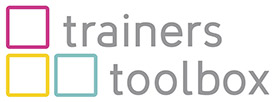
Empowering trainers to spark engagement and boost learning
- Trainers Toolbox Internship
- Train the trainer
- Train-the-Trainer Advanced (Level 2)
- Individual mentorship, consulting and coaching
- Optimal emotions for learning & Managing emotions in workshops
- brain-based-learning-course
- Positive psychology toolbox for trainers and coaches
- Keys to successful Virtual training on demand
10 Amazing Books to Boost Your Presentation Skills
- By Mirna Šmidt
- April 5, 2023
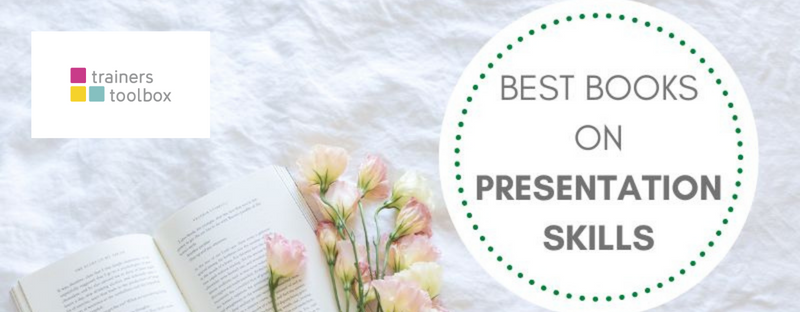
Whether you want to gain value for your trainer’s career, you want to improve your presentation skills generally in work and life, or you are training others in their presentation skills, we have some great approaches for you to explore.
You are always invited to also train your presentation skills with us at Trainers Toolbox ( discover more here or get in touch to discuss what works best for you) (make this embedded links to pres skills workshop and to contact form) – but in the meantime, these books will give you great new ideas, tools and insights on how to create an amazing, impactful and memorable presentations.
Bring your presentations to the next level!
Structure your presentation and make it memorable
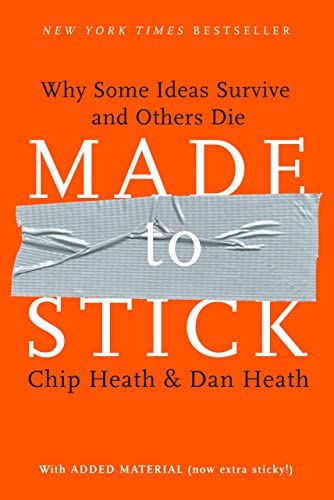
1. Chip Heath, Dan Heath: Made to Stick
Why do some ideas stick with us and others don’t? In an entertaining and eye-opening way, you will receive advice on how to make your ideas and communication more memorable.
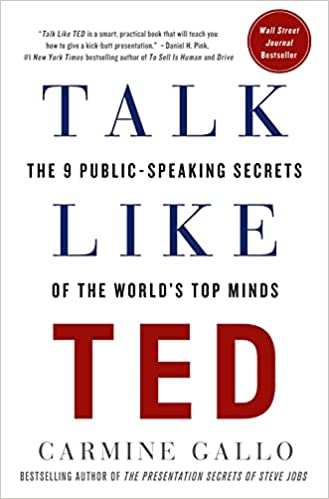
2. Carmine Gallo: Talk Like TED
Amazing insights on the secrets of public speaking. The author interviewed to most successful TED presenters and various scientists to form the ideas that will help you succeed as a speaker.
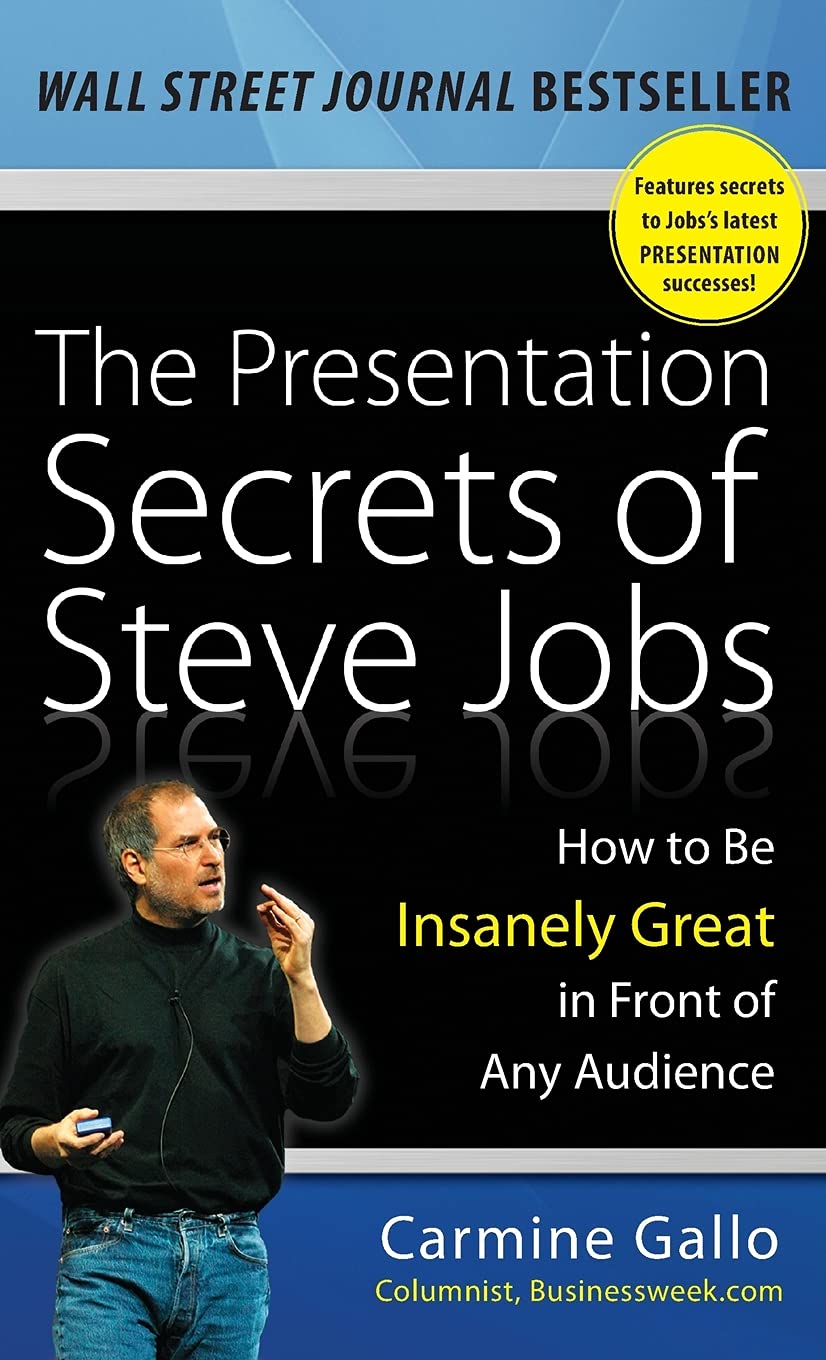
3. Carmine Gallo: The Presentation Secrets of Steve Jobs
Get passionate about the possibilities of your audiences! Using Steve Jobs as an example, you will discover lively techniques of the popular presenter.
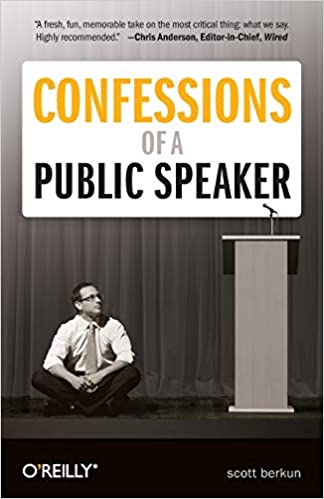
4. Scott Berkun: Confessions of a Public Speaker
Immerse in the world of great communication. Follow Berkun through 15 years of authentic experience, learning from his mistakes and understand what leads to his triumphs.
Building a clear message
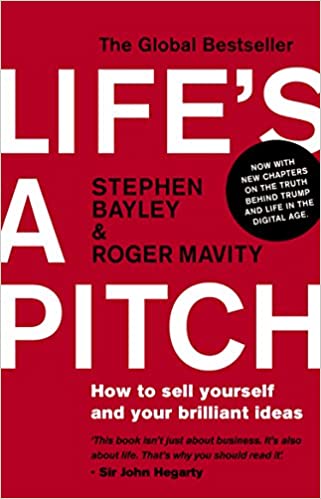
5. Roger Mavity, Stephen Bayley: Life’s a Pitch
Not only in the business world but also in your private life, sharing ideas and handle human transactions is necessary and important. You agree? Explore the art of persuasion and strengthen your skills, both in your presentations and in everyday communication!
Boost your design with the help of PowerPoint, on Whiteboard, or as drawing
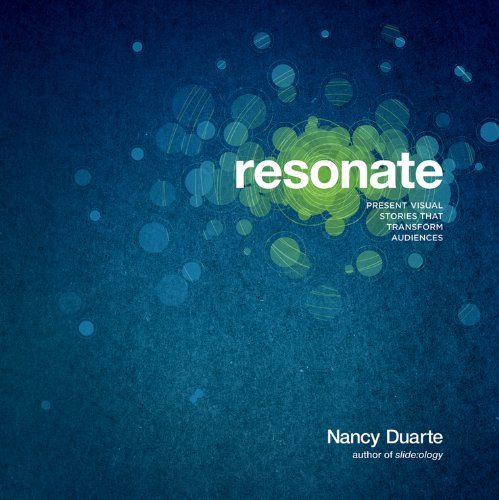
6. Nancy Duarte: Resonate
Build a strong connection with your audience by presenting visual stories. If you want to become a visual communicator, grab this one! It is one of the most amazing books on presentation skills - highly recommended!
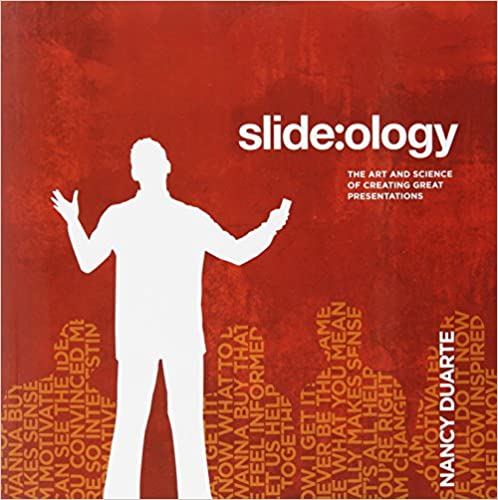
7. Nancy Duarte: slide:ology
This Nancy Duarte book is focused on designing you slides, and amazes with “walking the talk” throughout the book. It is highly practical, as well as rich in inspiring examples presented in a visual way.
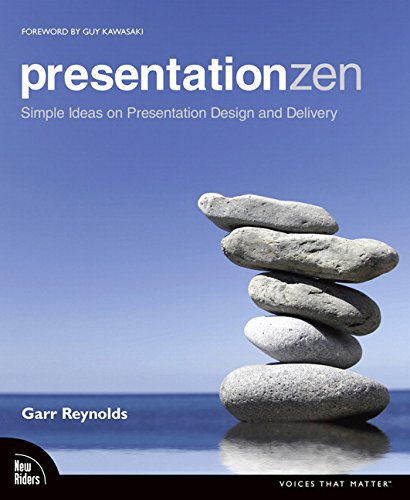
8. Garr Reynolds: Presentation Zen
Get ready for a new, creative and effective way you think about your presentations. Aiming for simplicity yet deep impact, this book is full of memorable lessons, but also beautiful examples how to make presentations stand out.
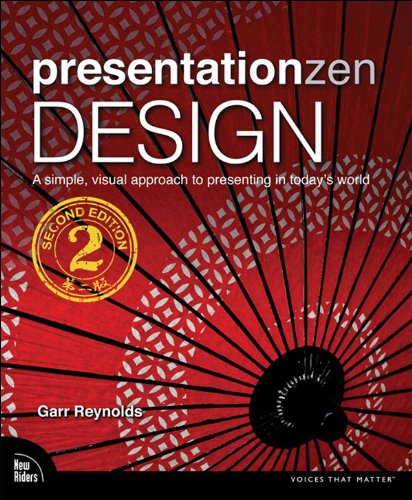
9. Garr Reynolds: Presentation Zen Design
Deep dive into effective PPT design, with many inspiring examples and practical tips.
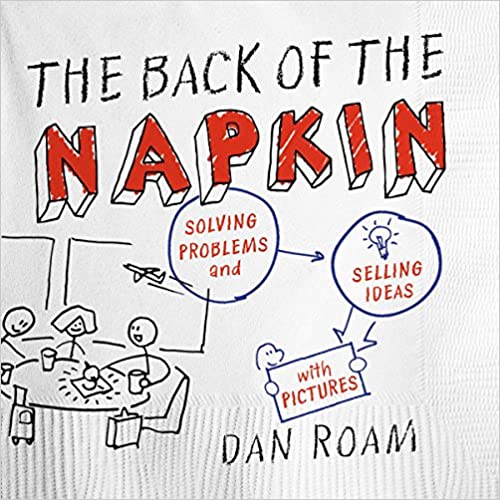
10. Dan Roam: The Back of the Napkin
If you are particularly interested in whiteboarding and drawing, don’t miss this opportunity to improve your skills. It is fascinating how visual representations can help solve complex problems.
Did you know that you can train your presentation skills with us at Trainers Toolbox?
Discover more about presentation skills workshops or get in touch to discuss how we can support you with your presentation skills development.
You May Also Like
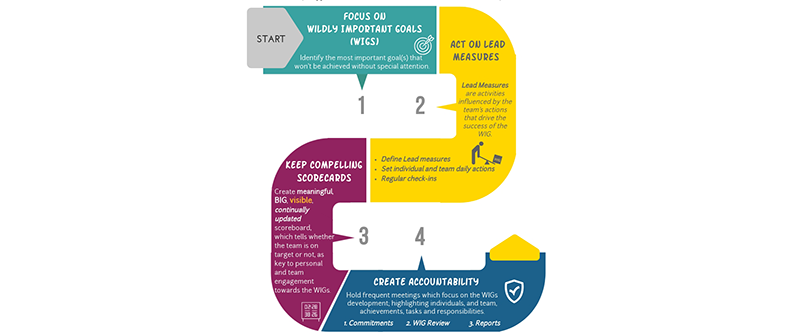
Exploring new frameworks to train leaders? You want to see this one!
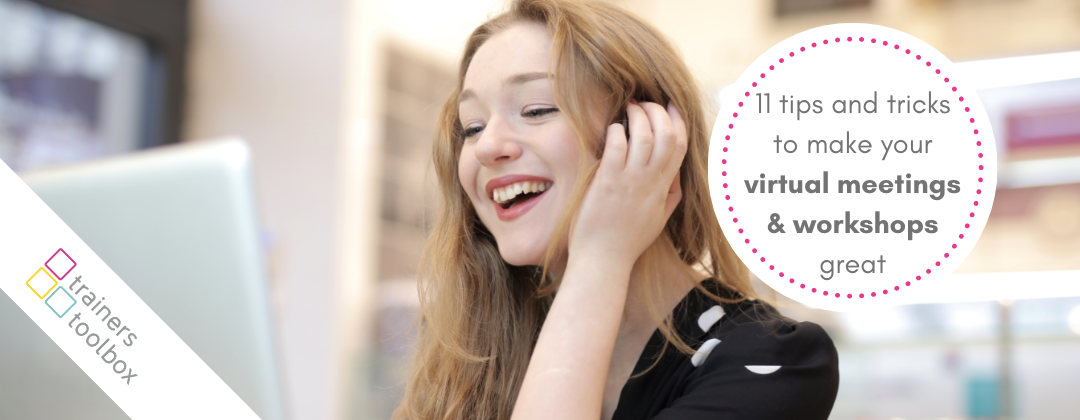
11 tips and tricks to make your virtual meetings & workshops great
How to add more movement to your workshops, no comments found.
- Speech Writing
- Delivery Techniques
- PowerPoint & Visuals
- Speaker Habits
- Speaker Resources
Speech Critiques
- Book Reviews
- Browse Articles
- ALL Articles
- Learn About Us
- About Six Minutes
- Meet Our Authors
- Write for Us
- Advertise With Us
Top 35 Presentation Books: Expert Ratings
Some are bad. Some are good. And some are outstanding!
We want to help you find the outstanding books — books which truly help you build your presentation skills . That’s why we publish book reviews on Six Minutes .
So, when Gonzalo Álvarez invited me to join in a survey of experts to rate a collection of the best presentation books, I was happy to participate.
This article reports the results of this survey: the top 35 books on presentations .
Analysis and Participants
From the analysis summary:
We wondered: “What do the top presentation experts in the world read?” They told us. We asked 7 of the top presentation experts in the world to tell us what books most inspired them to be better presenters. Seven judges, including four published authors, provided feedback to a list of books. We present, for your consideration, their ranked list of the top 35 presentation books.
- Survey analysis was performed by Gonzalo Álvarez and Bruce Gabrielle. Their methodology and full results can be found in the embedded document later in this article. Thanks to both of them for leading this effort!
- Nancy Duarte
- Bruce Gabrielle
- Dr. Michael Alley
- Gonzalo Alvarez
- Nolan Haims
- Andrew Dlugan (me)
Summary of the Results
- It’s very difficult to quantitatively compare speaking books, particularly when those books excel in very different ways.
- Books were scored according to their presentation focus along several criteria (content, structure, visual design, delivery). The total of the individual scores was used to rank the books overall.
- These totals can be misleading as they reward books with a very broad focus (books that touch on many speaking skills), and penalize books with a narrow focus. As an example, books like Made to Stick or The Story Factor (which are both excellent books which focus almost entirely on storytelling) receive low overall scores.
- Each of these two groups are listed in the tables below.
- The “Amazon Rating” column in the tables below gives the “stars” ranking and the number of reader reviews.
- Most books (27 out of 35) are priced between $14 and $28 . Four books are less than $14, and one book is over $28. Three books are no longer carried by amazon, so no price is given.
- Links to these reviews are given in the tables below.
- Most of the remaining 21 books are on my personal wishlist, so it’s quite likely you’ll be seeing reviews for some of them in the future.
Books with a Content/Delivery Focus
Books with a focus on visuals, the full ratings data.
If you do not see the embedded document below, please visit the web version of this article .
How about you? Which are your favorites?
How many of these 35 have you read? Which ones do you like most? Why? Which book(s) would you add to the list?
Please share in the comments . I’d love to hear from you.
Please share this...
This is one of many public speaking articles featured on Six Minutes . Subscribe to Six Minutes for free to receive future articles.
Add a Comment Cancel reply
E-Mail (hidden)
Subscribe - It's Free!
Similar articles you may like....
- Gifts Public Speakers Really Want: Dozens of Christmas Ideas
- 27 Hot Summer Reads for Speakers
- Popular Public Speaking Books and Gear
- Stocking Stuffers for Speakers
- Gifts for Every Speaker… from Zero to Eighty Dollars
- 25 Public Speaking Skills Every Speaker Must Have
Find More Articles Tagged:
14 comments.
The Art of the Explanation is my favorite. It’s written by Lee LeFever. He’s got steps on how to explain complicated things and ideas so NO ONE in the audience gets left behind.
Thanks Jaime.
I love Lee LeFever’s video explanations, and am curious to read his book.
2 Done; 33 to go. Wonderful timing. I was just looking for books to improve on my presentation skills. Andrew, you just handed over me the magic wand. 🙂
Thanks Andrew. Look forward to completing these.
Oh wow, that’s quite the list. I’ll be going over this and determining which ones I need to read NOW and which ones I’ll save for later. Thanks for taking the time to put together such a great list.
The one book I have never seen written is how to develop presentations for others to give. Many times I am faced with developing a corporate or sales presentation for the sales team to give to prospects – what are the best practices for this kind of presentation?
Thank you for providing an extremely useful list. However, it’s hard for anyone to keep up with what else those authors have been doing since the listed books were published. Check before you buy. For example, Stephen M. Kosslyn’s 2010 book Better PowerPoint: Quick Fixes Based on How Your Audience Thinks might be a better choice than the 2007 Clear and to the Point. Also, this year Dave Paradi published Present It So They Get It . I liked his The Visual Slide Revolution enough to post a review of it .
I’d add Dona M. Wong’s The Wall Street Journal Guide to Information Graphics to the list of books about visuals. I reviewed it briefly here .
Thanks for the detailed comments, Richard. I’ll have to check out those books.
considero una parte esencial de la vida el leer y leer pero el decidir cual o cuales libros son los mejores es dificil. por lo que agradezco esta presentacion seis minutos un momento de informacion que engrandece nuestro pensamiento. gracias
Since i am a scientist, my favorite is the craft of scientific presentation. I guess this one was intended for presenting scientific data and conference. For design, I prefer The non designer design book. For story telling, confessions of a public speaker is excellence. I read several other book, like the zen etc, but in my opinion they are for business-type presentation
a great list, but you left out a GEM. Gail Larsen’s Transformational Speaking . Truly, the best speaking book I’ve read.
MUST- ADD ALERT! Transformational Speaking , by Gail Larsen. This book is a comprehensive and unique guide to speaking with the most authentic voice we can bring forth. Gail’s teachings have not only helped me to become a better speaker, but have also helped me name and claim personal attributes that make me a better artist, workshop leader, friend, and mother. As former leader of the National Speaker’s Association, Gail knows the speaking world well. She can give a great speech any day at any time; but what interests her is the special ability we each possess to connect with people on a deeper level, through storytelling. In her book, Gail makes the case that if we don’t honor our unique offerings by sharing them, they will be lost to the world forever. She goes on to explain that this is a critical time in our world, a time we need everyone. Calling all voices! Please add this truly transformational gift to the world to your list of bests. I have never read a book that has changed my life more!
I think this is a great list you and your team have compliled. One I would add would be Jeremy Donovon’s How To Deliver A TED Talk which is a easy read that takes the best Ted Talks and dissects them.
I just read your ratings on the 35 presentation books and I can see I have a lot of reading a head of me.
I’m writing to you to ask if you would like to write a guest blog for our website? In return we can give you access to our PowerPoint Templates database and give you some room to promote your own product.
1 Blog Link
Business School Presenting – Especially Powerful Books for 2013! — Jan 17th, 2013
Featured Articles
- Majora Carter (TED, 2006) Energy, Passion, Speaking Rate
- Hans Rosling (TED, 2006) 6 Techniques to Present Data
- J.A. Gamache (Toastmasters, 2007) Gestures, Prop, Writing
- Steve Jobs (Stanford, 2005) Figures of speech, rule of three
- Al Gore (TED, 2006) Humor, audience interaction
- Dick Hardt (OSCON, 2005) Lessig Method of Presentation
Books We Recommend
Six Minutes Copyright © 2007-2019 All Rights Reserved.
Read our permissions policy , privacy policy , or disclosure policy .
Comments? Questions? Contact us .
- Speaker for Writers Events
- Testimonials
- Call for Speakers
- Guest Blog Post
- Share Call for Submissions
- Submit Feedback/Suggestions
- Contribute an Interview (MEMBERS)
- Member Directory
- Book Award Winners
- Interviews – Authors, Members, Experts
- Join Our Community
- Get Certified
- Member Home
- Member Login

- Join Us Here
- Thought Leader Membership
- Partner Membership – Service Providers
- Tour the Member Dashboard
- Member Testimonials
- Media Leads for Authors
- All Blog Posts
- Book Marketing
- Writing Nonfiction
- Professional Speaking
- Revenue Streams for Authors
- Live and On Demand Courses
- Professional Speaking Course for Authors
- Marketing Master Course
- Publishing Master Course
- Publicity Master Course
- All Upcoming Events
- Nonfiction Writers Conference
- Podcast Interviews
- Book Awards
- Entry Application
- Book Awards Payment
- Nonfiction Book Awards Categories
- Digital Award Seals
- Nonfiction Book Awards – FAQ
- Book Reviewers Apply Here
- Recommended Resources
- Virtual Assistants for Authors
- Publishing, Marketing, Publicity Consultants
- The Nonfiction Book Marketing and Launch Plan
- Free Reports for Authors
- NonfictionBookClub.com
- *CONFERENCE*
Select Page
8 Steps to Create a Dynamic Presentation from Your Book by Kirsten Holmberg
Posted by Guest Post | Nov 12, 2020 | Blog , Professional Speaking , PROFESSIONAL SPEAKING - MEMBERS ONLY | 0

Yet many authors—having poured their expertise into a robust written work—find the task of crafting speeches from their books daunting. Three common challenges include:
- Deciding what to put into the speech—because it requires leaving something from the book out.
- A lack of understanding of how the spoken word differs from the written word—and how to best serve a live audience with the right sentence and talk structure.
- Discomfort with being “on stage” as a speaker due to a preference for the more solitary work of writing.
To leverage speaking as part of your author platform and book publicity efforts, use these steps to craft and refine a talk based on your book:
- Know your audience. Ideally, you’ll initiate the process of crafting a talk with a particular audience in mind. If you haven’t yet been invited to speak, think about an event where you’d like to speak. Sketch out what you know about the audience: some general demographics, the purpose of the event, why your subject matter is of interest to them—and their underlying need. Don’t assume the audience is identical to the target audience of your book; identify ways they might be different as well as similar.
- Review (or create) your annotated table of contents. In light of the audience you’ll be addressing, which chapters would most effectively address their needs? It might only be one chapter and probably won’t be more than three. How does your content need to be adapted in light of any differences between the event audience and your book’s target audience? Don’t be afraid to tailor your content to the group; it shows care and fosters connection, through which your message is best conveyed. If you’re not sure, find someone in your network who is similar to the event’s audience and ask them which chapters would be most helpful. Aim to address a felt need with valuable, actionable information.
- Distill the selected chapters into their key points. Bulletize the key points instead of excerpting sentences or crafting new ones. Trust that you know your content and can speak to it without a full script. Writers rightly care a great deal about the turn of phrase and often want to write out their talks in full sentences. Yet this approach usually results in the speaker reading their talk instead of engaging the audience in a more conversational way; the latter is a profoundly more effective means of conveying the content. If you opt for a full script, take care to use simple sentence structure and common language: industry jargon and complex sentences are impediments to the audience’s ease of understanding.
- Structure the content to engage—and re-engage—the audience. They will assume your book is interesting if you and your talk are interesting. Hook them quickly; leverage your skills as a writer build and release tension multiple times during your speech. Leave them will a clear, concrete call to action—a step they can take immediately even if they don’t purchase the book. Aim to provide value and maintain a posture of service.
- Give the audience a gift. Share with them something you’ve learned since the book was published or give them a glimpse from behind the scenes of your book. Reward them for being part of the event by imparting some “insider information” they can’t get from the book. Consider addressing common questions that arise from the book content or sharing reactions from readers.
- Be human. You’re the subject-matter expert and the audience needs your knowledge. But they also want you to be human. Establish common ground; show them—within the first few minutes—that you understand their needs because you have similar needs. Be willing to share some relevant faults or failings for the sake of conveying empathy for the shared human experience as it relates to your content.
- Visualize your content. Audiences today are accustomed to visual accompaniment, most often in the form of slides. And slides really should be visual , not merely a list of words to prompt the speaker what to say. As wordsmiths, creating slides may not be a natural strength. Spend the time and energy to craft quality slides; involve friends with complementary skill sets or hire a designer if you lack the skills to do it well. Just as in writing, take care to avoid visual clichés. Check out com for symbols and images. Leverage pictures or graphics from your book where appropriate.
- Refine the delivery. Your book represents you: your expertise, your thoughts, your story. But when you’re on stage, you represent your book. Merely knowing your subject matter isn’t sufficient for giving a great talk; you need to deliver it in a fashion that is clear, confident, and compelling. Audiences will determine whether they find you (and your book) credible in large part based on how well you present yourself. Plan to practice your speech daily, videotaping yourself several times and taking the time to review and evaluate the footage to identify areas needing improvement (this free rubric is a helpful guide for doing so).
Speaking is an essential component of a successful author platform, driving book sales and increasing visibility in the publishing world.
You’ve written the book you know the world needs; now use your voice to share that message in a spoken format.
About Kirsten Holmberg
Kirsten Holmberg is a public speaking coach and trainer who has worked with TEDx speakers and clients from Fortune 50 companies, including Google, HP, and Oracle. Leveraging two decades of experience in keynote speaking, she equips both new and skilled speakers to achieve maximum impact with their presentations to customers, stakeholders, and audiences of all sizes. Learn more about Kirsten at www.kirstenholmberg.com .
Facebook: https://www.facebook.com/kirholmberg
IG: https://www.instagram.com/kirholmberg/
Twitter: https://twitter.com/kirholmberg
LinkedIn: https://www.linkedin.com/in/kirstenholmberg/
If you like this blog post, you’ll love our Author Toolkit for book marketing . It includes checklists, templates, worksheets and more. Check it out!
About The Author
Related Posts

Publishing FAQ: Should I Bother Publishing My Ebook in Print?
The pros and cons of traditional vs. self-publishing.

Should You Rely on Intuition When Making Marketing Decisions? By Brian Jud

Get More Book Reviews on Amazon
Leave a reply cancel reply.
Your email address will not be published. Required fields are marked *
This site uses Akismet to reduce spam. Learn how your comment data is processed .
Book Publicity Master Course Returns May 21, 2024

The popular Book Publicity Course with optional professional certification returns LIVE starting May 21. If you want to get media attention, this course is for you! Register here.
Weekend Workshop at Omega Institute in New York

Join NFAA CEO Stephanie Chandler for an in-person weekend workshop on how to write and publish your nonfiction book. July 26-28 at the Omega Institute in Rhinebeck, New York. Learn more here.
NEW BOOK! The Nonfiction Book Marketing and Launch Plan – Workbook and Planning Guide

Are you ready to sell more books? This comprehensive workbook includes over 250 pages of value in a size 8.5 x 11 format. It will help you develop effective marketing plans so you can grow your audience and sell more books. Get the Book Here
Download Our Popular Free Reports

ONLINE COURSES FOR NONFICTION WRITERS

Upcoming Events for Nonfiction Writers

DOWNLOAD OUR FREE REPORT: ULTIMATE GUIDE TO BETA READERS

JOIN THE NONFICTION AUTHORS ASSOCIATION

New Nonfiction Book Club site

Recent Posts
- How to Make the Most Out of Your Book Marketing: Think About Whether Your Audience Spends Time There 05/17
- How to Monetize Your Content 05/16
- Book Award Winner: Killing Time with John Wayne Gacy: Defending America’s Most Evil Serial Killer on Death Row by Karen Conti 05/16

14 Practical Tips to Improve Your Presentation Skills
- The Speaker Lab
- May 11, 2024
Table of Contents
Ever felt complete dread and fear at the thought of stepping up to deliver a presentation? If so, you’re not alone. The fear of public speaking is more common than you might think, but with the right presentation skills , it’s a hurdle that can be overcome.
In this article, we’ll help you master basic confidence-building techniques and conquer advanced communication strategies for engaging presentations. We’ll explore how body language and eye contact can make or break your connection with your audience; delve into preparation techniques like dealing with filler words and nervous habits; discuss tailoring content for different audiences; and much more.
Whether you’re prepping for job interviews or gearing up for big presentations, being prepared is key. With adequate practice and the proper attitude, you can crush your speech or presentation!
Mastering the Basics of Presentation Skills
Presentation skills are not just about speaking in front of a crowd. It’s also about effective communication, audience engagement, and clarity. Mastering these skills can be transformative for everyone, from students to corporate trainers.
Building Confidence in Presentations
Becoming confident when presenting is no small feat. But fear not. Even those who feel jittery at the mere thought of public speaking can become masters with practice and patience. Just remember: stage fright is common and overcoming it is part of the process towards becoming an effective presenter.
Taking deep breaths before you start helps calm nerves while visualizing success aids in building confidence. Also, know that nobody minds if you take a moment to gather your thoughts during your presentation—everybody minds more if they cannot understand what you’re saying because you’re rushing.
The Role of Practice in Enhancing Presentation Skills
In line with old wisdom, practice indeed makes perfect, especially when improving presentation skills. Consistent rehearsals allow us to fine-tune our delivery methods like maintaining eye contact or controlling body language effectively.
You’ll learn better control over filler words through repeated drills. Plus, the extra practice can help you troubleshoot any technical glitches beforehand, saving you the sudden panic during your actual presentations.
Remember that great presenters were once beginners too. Continuous effort will get you there sooner rather than later.
Find Out Exactly How Much You Could Make As a Paid Speaker
Use The Official Speaker Fee Calculator to tell you what you should charge for your first (or next) speaking gig — virtual or in-person!
Body Language and Eye Contact in Presentations
The effectiveness of your presentation can hinge on more than just the words you say. Just as important is your body language .
Impact of Posture on Presentations
Your posture speaks volumes before you utter a word. Standing tall exudes confidence while slouching could signal nervousness or lack of preparation.
If there’s one lesson to take away from our YouTube channel , it’s this: good presenters know their message but great ones feel it through every fiber (or muscle) of their being. The audience can sense that energy when they see open body language rather than crossed arms.
Maintaining Eye Contact During Your Presentation
Eyes are often called windows to the soul for a reason. They’re communication powerhouses. Making eye contact helps build trust with your audience members and keeps them engaged throughout your speech.
Avoid staring at note cards or visual aids too much as this might give an impression that you’re unprepared or uncertain about your chosen topic. Instead, aim to maintain eye contact between 50% of the time during presentations. This commonly accepted “50/70 rule” will help you exhibit adequate confidence to your audience.
If stage fright has gotten a hold on you, take deep breaths before you start speaking in order to stay calm. Make sure that fear doesn’t disrupt your ability to maintain eye-contact during presentations.
If body language and eye contact still feel like a lot to manage during your big presentation, remember our golden rule: nobody minds small mistakes. It’s how you handle questions or mishaps that truly makes a difference—so stay positive and enthusiastic.
Preparation Techniques for Successful Presentations
Presentation skills are like a craft that requires meticulous preparation and practice. Aspects like visual aids and time management contribute to the overall effectiveness of your delivery.
The first step towards delivering an impactful presentation is research and organization. The content should be well-researched, structured logically, and presented in simple language. This will make sure you deliver clear messages without any room for misinterpretation.
Dealing with Filler Words and Nervous Habits
Nervous habits such as excessive use of filler words can distract from your message. Luckily, there are plenty of strategies that can address these issues. For instance, try taking deep breaths before speaking or using note cards until fluency is achieved. In addition, practice regularly to work on eliminating these verbal stumbling blocks.
Avoiding Distractions During Presentations
In a digital age where distractions abound, maintaining focus during presentations has become an even more crucial part of the preparation process. This video by motivational speaker Brain Tracy provides insights on how one could achieve this level of focus required for effective presentations.
Maintaining Confidence Throughout Your Presentation
Confidence comes from thorough understanding of the chosen topic combined with regular practice sessions before the big day arrives. Make use of note cards or cue cards as needed but avoid reading from them verbatim.
Taking control over stage fright starts by arriving early at the venue so that you familiarize yourself with the surroundings, which generally calms nerves down considerably. So next time you feel nervous before a big presentation, remember—thorough preparation can make all the difference.
Engaging Your Audience During Presentations
Connecting with your audience during presentations is an art, and mastering it can take your presentation skills to the next level. Making the message conveyed reach an emotional level is essential, not just conveying facts.
Understanding Your Target Audience
The first step towards engaging your audience is understanding them. Tailor the content of your presentation to their needs and interests. Speak in their language—whether that be professional jargon or everyday slang—to establish rapport and ensure comprehension.
An effective presenter understands who they’re speaking to, what those individuals care about, and how best to communicate complex ideas understandably.
Making Complex Information Understandable
Dense data or complicated concepts can lose even the most interested listener if presented ineffectively. Breaking your key points down into manageable chunks helps maintain attention while promoting retention. Analogies are especially useful for this purpose as they make unfamiliar topics more relatable.
Audience Participation & Questions: A Two-Way Street
Incorporating opportunities for audience participation encourages engagement at another level. It allows listeners to become active participants rather than passive receivers of knowledge.
Consider techniques like live polls or interactive Q&A sessions where you invite questions from attendees mid-presentation instead of saving all queries until the end.
This gives you a chance not only engage but also address any misunderstandings right on spot.
- Treat each question asked as an opportunity—it’s evidence someone has been paying attention. Even challenging questions should be welcomed as they demonstrate an engaged, thoughtful audience.
- Encourage participation. It can be as simple as a show of hands or the use of interactive technologies for live polling during your presentation. This keeps your audience active and invested in the content.
Remember, your presentation isn’t just about putting on a show—it’s about meaningful interaction.
Free Download: 6 Proven Steps to Book More Paid Speaking Gigs in 2024
Download our 18-page guide and start booking more paid speaking gigs today!
Presentation Skills in Specific Contexts
Whether you’re nailing your next job interview, presenting an exciting marketing campaign, or delivering insightful educational content, the context matters. Let’s take a look.
The Art of Job Interviews
A successful job interview often hinges on effective communication and confidence. Here, the target audience is usually small but holds significant influence over your future prospects. Body language plays a crucial role; maintain eye contact to show sincerity and interest while open body language communicates approachability.
Bullet points summarizing key experiences are also helpful for quick recall under pressure. This allows you to present your chosen topic with clarity and positive enthusiasm without relying heavily on note or cue cards.
Pitching in Public Relations & Marketing
In public relations (PR) and marketing contexts, presentations need to capture attention quickly yet hold it long enough to deliver key messages effectively. Visual aids are valuable tools here—they help emphasize points while keeping the audience engaged.
Your aim should be highlighting presentation benefits that resonate with potential clients or partners, making them feel as though ignoring such opportunities would mean missing out big time.
Educational Presentations
An educational setting demands its own unique set of presentation skills where deep understanding trumps flashy visuals. You must make complex information understandable without oversimplifying essential details—the use of analogies can be beneficial here.
Keeping the audience’s attention is critical. Encourage questions and participation to foster a more interactive environment, enhancing learning outcomes for all audience members.
Tips for Becoming a Great Presenter
No single method is suitable for everyone when it comes to speaking in public. However, incorporating continuous improvement and practice into your routine can make you an exceptional presenter.
Tailor Your Presentation to Your Audience
Becoming an excellent speaker isn’t just about delivering information; it’s also about making a connection with the audience. So make sure that you’re taking setting, audience, and topic into consideration when crafting your presentation. What works for one audience may not work for another, so be sure to adapt your presentation styles according to the occasion in order to be truly effective.
The Power of Practice
The art of mastering public speaking skills requires practice —and lots of it . To become a great presenter, focus on improving communication skills through practice and feedback from peers or mentors. Try to seek feedback on every speech delivered and incorporate those pointers in your future presentations. Over time, this cycle of delivery-feedback-improvement significantly enhances your ability to connect with audiences and convey ideas effectively.
If you’re looking for examples of good speakers, our speech breakdowns on YouTube provide excellent examples of experienced presenters who masterfully utilize speaking techniques. Analyzing their strategies could give you great ideas for enhancing your own style.
Finding Your Style
A crucial part of captivating any audience lies in how you deliver the message rather than the message itself. Developing a unique presentation style lets you stand out as an engaging speaker who commands attention throughout their talk. Through — you guessed it — practice, you can develop a personal presentation style that resonates with listeners while showcasing your expertise on the chosen topic.
Your body language plays a pivotal role here: open gestures communicate confidence and enthusiasm towards your subject matter, two qualities essential for keeping audiences hooked. Similarly, using vocal variety adds dynamism to speeches by emphasizing points when needed or creating suspense during storytelling parts of your talk.
Cultivating Passion & Enthusiasm
Showcasing genuine passion for the subject helps keep listeners engaged throughout even lengthy presentations. Sharing stories related to the topic or expressing excitement about sharing knowledge tends to draw people in more than mere data recitation ever could.
Recognize that everybody is distinctive; don’t expect identical results from every speaker. The path to becoming a great presenter involves recognizing your strengths and working tirelessly on areas that need improvement.
FAQs on Presentation Skills
What are good presentation skills.
Good presentation skills include a clear message, confident delivery, engaging body language, audience understanding, and interaction. They also involve effective preparation and practice.
What are the 5 steps of presentation skills?
The five steps of presenting include: planning your content, preparing visual aids if needed, practicing the delivery aloud, performing it with confidence, and finally post-presentation reflection for improvements.
What are the 5 P’s of presentation skills?
The five P’s stand for Preparation (researching your topic), Practice (rehearsing your talk), Performance (delivering with confidence), Posture (standing tall), and Projection (using a strong voice).
What are your presentation skills?
Your personal set of abilities to deliver information effectively is what we call your presentation skill. It can encompass public speaking ability, clarity in speech or writing as well as visual communication talent.
Mastering presentation skills isn’t an overnight process, but practice and perseverance will put you well on your way to becoming an effective speaker.
You’ve learned that confidence plays a crucial role in effective presentations, so take deep breaths, make eye contact, and keep your body language open. As always, preparation is key. Tackle filler words head-on and get comfortable with visual aids for impactful storytelling.
Remember the importance of audience engagement — it’s all about understanding their needs and tailoring your content accordingly. This way, complex information turns into digestible insights.
Above all else: practice! After all, nothing beats experience when it comes to improving public speaking abilities.
- Last Updated: May 9, 2024

Explore Related Resources
Learn How You Could Get Your First (Or Next) Paid Speaking Gig In 90 Days or Less
We receive thousands of applications every day, but we only work with the top 5% of speakers .
Book a call with our team to get started — you’ll learn why the vast majority of our students get a paid speaking gig within 90 days of finishing our program .
If you’re ready to control your schedule, grow your income, and make an impact in the world – it’s time to take the first step. Book a FREE consulting call and let’s get you Booked and Paid to Speak ® .
About The Speaker Lab
We teach speakers how to consistently get booked and paid to speak. Since 2015, we’ve helped thousands of speakers find clarity, confidence, and a clear path to make an impact.
Get Started
Let's connect.
Copyright ©2023 The Speaker Lab. All rights reserved.
Got any suggestions?
We want to hear from you! Send us a message and help improve Slidesgo
Top searches
Trending searches

11 templates

67 templates

21 templates

environmental science
36 templates

9 templates

holy spirit
Book review, it seems that you like this template, book review presentation, free google slides theme, powerpoint template, and canva presentation template.
Review your favourite book with this geometric template. We have included some maps, chapter timelines and percentages to help you with your task. Keep reading!
Features of this template
- A simple design with geometric patterns
- 100% editable and easy to modify
- 33 different slides to impress your audience
- Contains easy-to-edit graphics such as tables, charts, diagrams and maps
- Includes 500+ icons and Flaticon’s extension for customizing your slides
- Designed to be used in Google Slides, Canva, and Microsoft PowerPoint
- 16:9 widescreen format suitable for all types of screens
- Includes information about fonts, colors, and credits of the free resources used
How can I use the template?
Am I free to use the templates?
How to attribute?
Attribution required If you are a free user, you must attribute Slidesgo by keeping the slide where the credits appear. How to attribute?
Related posts on our blog.

How to Add, Duplicate, Move, Delete or Hide Slides in Google Slides

How to Change Layouts in PowerPoint

How to Change the Slide Size in Google Slides
Related presentations.
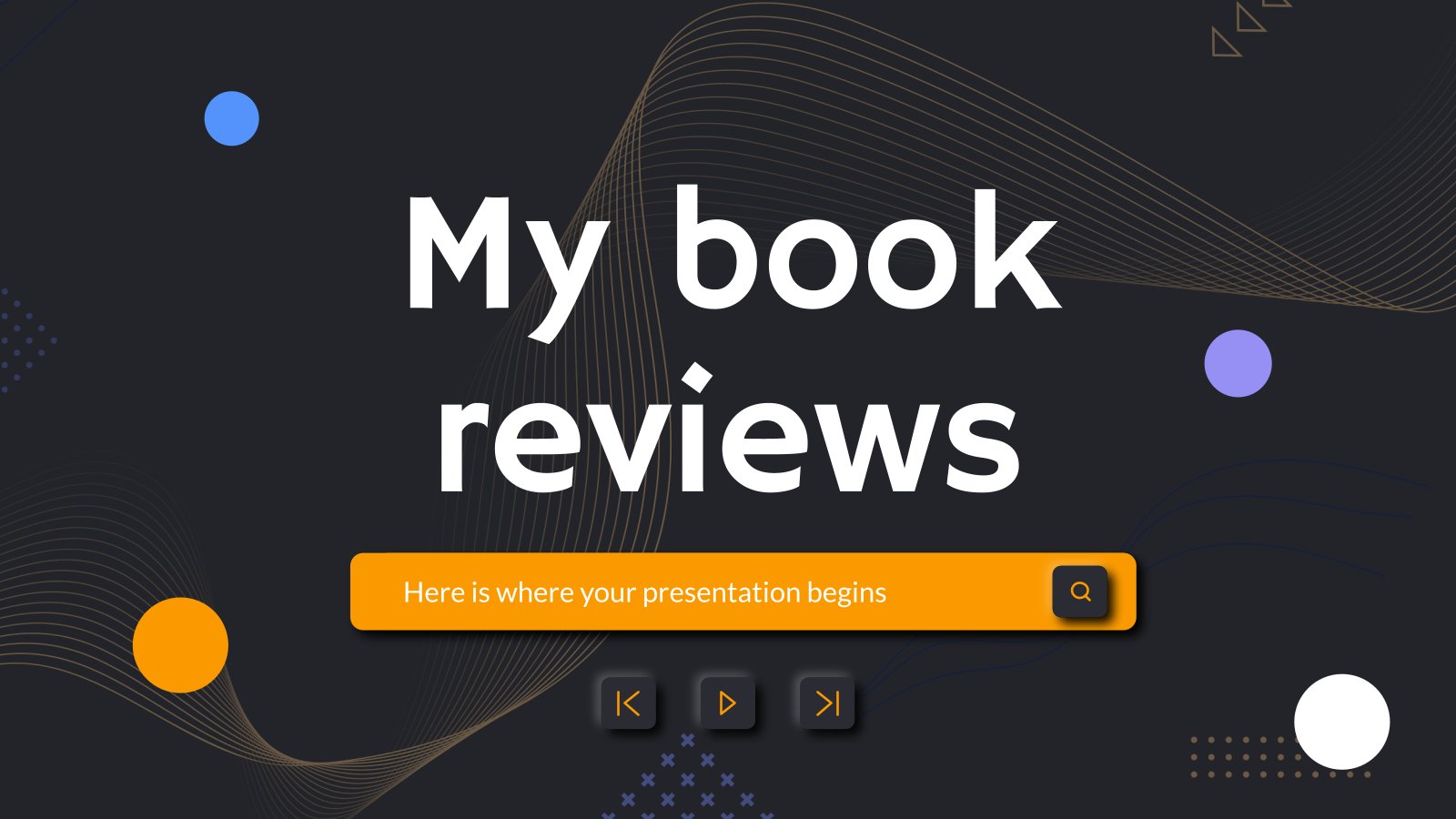
Premium template
Unlock this template and gain unlimited access

Register for free and start editing online

10 Tips for a Persuasive Presentation
Powerful presentation is persuasion. here's how to elevate your impact..
Posted May 11, 2024 | Reviewed by Ray Parker
- Presentations aim to effect change. It's essential to be clear about what change you want to see.
- Powerful presenters embrace and extend empathy to seek first to understand their audience.
- Substance and style both matter to create an audience-informed communication experience.
- Persuasive presentations are relevant, reasoned, real, and resonant.

How many of us realize that giving a presentation or making a speech is all about persuasion , influence, and emotional intelligence ? Impactful presenters understand the power of empathy to understand and engage their audience, the efficiency and kindness of having a clear objective and message, and the importance of substance and style—all as a way to connect in a way that engages and inspires.
Much has been written on the power and behavioral science of persuasion, not least by expert Robert Cialdini. His bestselling book Influence: The Psychology of Persuasion explains seven research-based universal principles of influence .
From my experience as a leadership coach working with thousands of people worldwide, I have compiled a list of ten essentials to elevate our presentation.
1. Maintain an "other" focus. What do you know about your audience and how can you find out more? Ask yourself what kind of a speaker will appeal to your audience, what arguments are likely to resonate with them, and what feelings you want to inspire so the audience will positively respond to your ask.
If your audience is predominantly data-driven, you may want to use more evidence-based arguments. If the audience is mixed, a combination of data, authority, and storytelling may be more appropriate. Extend Daniel Goleman’s three types of empathy to gather intelligence , understand your audience, and tailor your intervention to connect more profoundly.
2. Determine a specific objective. Presentations aim to effect change in some way. What change do you want to see in your audience?
For instance, gaining their approval for a certain investment, soliciting their buy-in for a change, or creating a sense of enthusiasm for an idea or initiative. The purpose of a presentation is to bring about change so make sure you are clear on what kind of change you want to bring about.
3. Design a grabber. Our attention spans have shrunk as we have more and more competing demands on our attention . If you want to get someone’s attention, you need to grab it at the outset and try and hold on.
You can do this in several different ways. Throw out a question that demands a response from the audience. Give a surprising fact or statistic, or quote from a well-known figure. Tell a story or an anecdote. A good grabber captures the attention of everyone there and makes them focus on what you have to say.
4. Crystalize your message and construct your arguments. Your message is the heart of your speech. Craft a brief phrase that clearly defines your proposal in 10-12 words—for example, “This post is about crafting presentations that inspire and engage others to elevate their presentations.”
Make it memorable by choosing inspiring words, symbols, catchy expressions, something that will remain in the audience's mind. As Brené Brown says: “Clear is kind,” and a clear message provides a path to develop your ideas.
When you have a clear and concise message, it helps you formulate your arguments. Think of developing your arguments using the rule of three —three compelling arguments to convince but not overwhelm your audience.
5. Prepare a call to action. Remember, we want to change our audience in some way, so we need to make our ask clearly and concretely. Consider your call to action in terms of what you want your audience to think/feel/do:
- Think: “I want you to think about how you can improve your presentations.”
- Feel: “I want you to feel enthusiastic and motivated so that you can elevate your power to persuade.”
- Do: “I want you to try out some of these tips and tools for yourself.”
6. Craft a memorable closing. Close the speech in an elegant and memorable way. We need people to remember what we've told them, so prepare it well.

This is not the time to improvise. Try to connect your closing to your opening grabber, which makes the presentation more memorable. Good preparation means preparing everything to the very end—finish well.
7. Plan your delivery. A dynamic speaker draws listeners in by using vocal variety (tone, intonation, speed, volume, pace, pauses, silence) and body language (posture, gestures, expression, and movement) to highlight important points and hold the audience’s attention. Be intentional: How will you use your voice and your body to emphasize a thought or idea? Think about it: If you increased the time you spent on style or delivery by 20 percent, what would it mean for the impact you make?
8. Think about how you will engage your audience. You want the audience to feel considered throughout. Include pauses so they can process what’s being said; connect with individuals throughout the room and make deliberate eye contact while speaking, especially when delivering key points. Read and respond to the audience by changing how you deliver as you go based on the audience’s nonverbal communication .
9. Rehearse and practice. Practice is one of the most crucial elements of presenting—and probably the most neglected one. If this is new to you, start by reading your presentation in front of a mirror to get comfortable speaking your presentation.
Next, video yourself and watch out for nervous or distracting habits to eliminate them and identify any areas where you can improve your delivery. If you are feeling brave, practice in front of an audience and ask for feedback.
10. Prepare your success rituals and mantra. Public speaking and/or stage fright can feel debilitating for some. Have your calm-down ritual prepared and ready to go before you start your presentation. This might be a certain gesture, a power pose, breathwork, or a mantra.
Try this tip: Identify three adjectives to describe how you would like to show up during this presentation. This sets an intention and helps focus our cognitive and emotional resources on success.
Powerful presenters embrace and extend empathy to seek first to understand their audience. They use this intelligence to carefully make choices about substance and style to create an audience-informed communication experience that feels relevant, reasoned, real, and resonant and creates a pathway for change.

Palena Neale, Ph.D. , is a women’s leadership coach, lecturer, and founder of unabridged, a boutique leadership development practice.
- Find a Therapist
- Find a Treatment Center
- Find a Psychiatrist
- Find a Support Group
- Find Online Therapy
- United States
- Brooklyn, NY
- Chicago, IL
- Houston, TX
- Los Angeles, CA
- New York, NY
- Portland, OR
- San Diego, CA
- San Francisco, CA
- Seattle, WA
- Washington, DC
- Asperger's
- Bipolar Disorder
- Chronic Pain
- Eating Disorders
- Passive Aggression
- Personality
- Goal Setting
- Positive Psychology
- Stopping Smoking
- Low Sexual Desire
- Relationships
- Child Development
- Self Tests NEW
- Therapy Center
- Diagnosis Dictionary
- Types of Therapy

At any moment, someone’s aggravating behavior or our own bad luck can set us off on an emotional spiral that threatens to derail our entire day. Here’s how we can face our triggers with less reactivity so that we can get on with our lives.
- Emotional Intelligence
- Gaslighting
- Affective Forecasting
- Neuroscience
- SUGGESTED TOPICS
- The Magazine
- Newsletters
- Managing Yourself
- Managing Teams
- Work-life Balance
- The Big Idea
- Data & Visuals
- Reading Lists
- Case Selections
- HBR Learning
- Topic Feeds
- Account Settings
- Email Preferences
Create an Effective Slide Deck
A great presentation depends on more than the high-quality information you’re sharing. Here are some essential principles to help you create a memorable slide deck. Choose the right fonts. Use sans serif fonts like Helvetica or Arial for a minimal look and better readability. Stick to two font styles throughout your presentation—one for headings and another […]
A great presentation depends on more than the high-quality information you’re sharing. Here are some essential principles to help you create a memorable slide deck.
Source: This tip is adapted from “How to Make a ‘Good’ Presentation ‘Great’” by Guy Kawasaki
Partner Center

IMAGES
VIDEO
COMMENTS
Step 1: Choose the right book. The first step in making a book presentation is selecting the right book. Consider your audience, the purpose of the presentation, and your own interests. Choose a book that aligns with these factors to ensure you'll be motivated and passionate throughout the process. Step 2: Read and analyze the book
Apply the 10-20-30 rule. Apply the 10-20-30 presentation rule and keep it short, sweet and impactful! Stick to ten slides, deliver your presentation within 20 minutes and use a 30-point font to ensure clarity and focus. Less is more, and your audience will thank you for it! 9. Implement the 5-5-5 rule. Simplicity is key.
Here are a few tips for business professionals who want to move from being good speakers to great ones: be concise (the fewer words, the better); never use bullet points (photos and images paired ...
When in doubt, adhere to the principle of simplicity, and aim for a clean and uncluttered layout with plenty of white space around text and images. Think phrases and bullets, not sentences. As an ...
1. Speak to Win. Subtitle: How to Present With Power in Any Situation. Author: Brian Tracy. Why It's Worth Reading: While Tracy's other books are more famous, this one takes the author's deep ...
Structure Your Presentation Like a Story. by. Nancy Duarte. October 31, 2012. PM Images/Getty Images. After studying hundreds of speeches, I've found that the most effective presenters use the ...
Data visualization: Presenting complex data in a clear and concise manner is a critical skill in effective presentations. Slide preparation and organization: The book offers strategies for organizing slides and building a coherent flow throughout the presentation. Buy Slideology On Amazon.
The secret structure of great talks. From the "I have a dream" speech to Steve Jobs' iPhone launch, many great talks have a common structure that helps their message resonate with listeners. In this talk, presentation expert Nancy Duarte shares practical lessons on how to make a powerful call-to-action. 18:00.
The Non-Designer's Presentation Book: Principles for effective presentation design by Robin Williams. This book has helped countless non-designers find their presentation mojo. It's based around four easy-to-understand design principles and guides readers in creating a presentation from start to finish.
1. Art of the Pitch: Persuasion and Presentation Skills That Win Business. by Peter Coughter. The author of this narrative book has worked with some of the best advertising agencies in the world ...
Here are our six must-read presentation books we'd recommend you add to your home library. 1. Talk Like TED: The 9 Public Speaking Secrets of the World's Top Minds, Carmine Gallo. In this book, Carmine Gallo puts forward a straightforward step-by-step method for anyone to deliver a presentation that is engaging, persuasive, and most ...
So, to cut a long story short here are 5 useful tips on how to make a book presentation: Select a book. Decide on what book you want to make a presentation. Collect information. Make a research about the author's biography, reviews, and other books. Start designing the page layouts.
How to Give a Pretty Good Presentation is the easy answer to this common need. Straightforward, entertaining, and well-organized, this user-friendly resource will walk you step-by-step through the process from how to write, rehearse, and deliver a pretty good presentation that will make you appear confident, memorable, and competent.
Making a good presentation isn't as difficult as you may think. This book will show you a simple step by step method which covers understanding your audience, how to create an effective PowerPoint slide, how to use effective presentation skills and more. By creating a good presentation your audience will leave the room remembering more and you ...
Good focus on timeless ideas; The print book is beautifully designed; Wishlist. More hands-on exercises and activities; Bottom Line . This book is perfect for anyone looking to master the art of creating visually stunning and impactful presentations, regardless of their design background.
In fact, as you prepare to make your presentation, you may find that your writing skills are quite useful. You can leverage those skills by following these seven tips to write a killer book presentation. 1. Use Your Storytelling Skills. The people attending your presentation want to know the story behind your book.
It is one of the most amazing books on presentation skills - highly recommended! 7. Nancy Duarte: slide:ology. This Nancy Duarte book is focused on designing you slides, and amazes with "walking the talk" throughout the book. It is highly practical, as well as rich in inspiring examples presented in a visual way. 8.
As an example, books like Made to Stick or The Story Factor (which are both excellent books which focus almost entirely on storytelling) receive low overall scores. 21 books have a content/delivery focus; 14 focus on visuals . Each of these two groups are listed in the tables below. Most books (31 out of 35) are rated 4 out of 5 stars or higher ...
Frame your story (figure out where to start and where to end). Plan your delivery (decide whether to memorize your speech word for word or develop bullet points and then rehearse it—over and ...
Speaking gigs are a key ingredient in book publicity and building an author platform. An author's interaction with an audience often generates book sales. Likewise, strong demand for a book creates more opportunities for speaking. The relationship is symbiotic. Yet many authors—having poured their expertise into a robust written work—find the task of crafting speeches […]
Instead, aim to maintain eye contact between 50% of the time during presentations. This commonly accepted "50/70 rule" will help you exhibit adequate confidence to your audience. If stage fright has gotten a hold on you, take deep breaths before you start speaking in order to stay calm.
Include the year it was published, number of pages and what genre the book falls under. Describe each of the main characters in the book and talk about how each influences the story. Provide an explanation of your perceptions and thoughts regarding the book. While the rest of your presentation may be in third-person, you can usually write this ...
Get your main point into the presentation as early as possible (this avoids any risk of audience fatigue or attention span waning), then substantiate your point with facts, figures etc and then reiterate your point at the end in a 'Summary'. 2. Practice Makes Perfect. Also, don't forget to practice your presentation.
Free Google Slides theme, PowerPoint template, and Canva presentation template. Review your favourite book with this geometric template. We have included some maps, chapter timelines and percentages to help you with your task. Keep reading!
Hi Everyone, in this video you will learn how to design realistic book presentation in PowerPoint
5. Prepare a call to action. Remember, we want to change our audience in some way, so we need to make our ask clearly and concretely. Consider your call to action in terms of what you want your ...
Some of the best presentation topic ideas for students center around topics such as current events, education, general culture, health, life skills, literature, media and science. When picking presentation topics, consider these things: your hobbies, the books you read, the kind of TV shows you watch, what topics you're good at and what you ...
Here are some essential principles to help you create a memorable slide deck. Choose the right fonts. Use sans serif fonts like Helvetica or Arial for a minimal look and better readability. Stick ...
Prior to GPT-4o, you could use Voice Mode to talk to ChatGPT with latencies of 2.8 seconds (GPT-3.5) and 5.4 seconds (GPT-4) on average. To achieve this, Voice Mode is a pipeline of three separate models: one simple model transcribes audio to text, GPT-3.5 or GPT-4 takes in text and outputs text, and a third simple model converts that text back to audio.